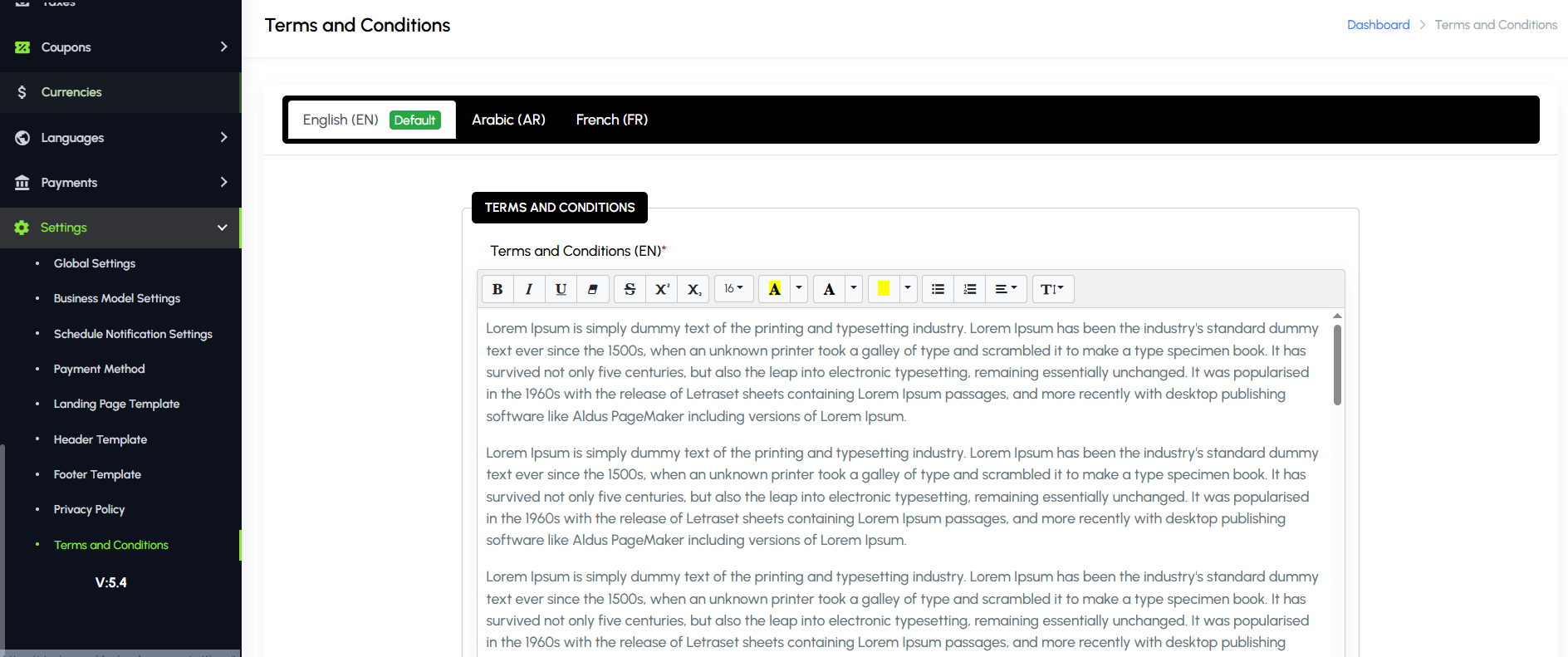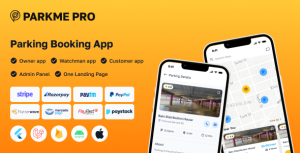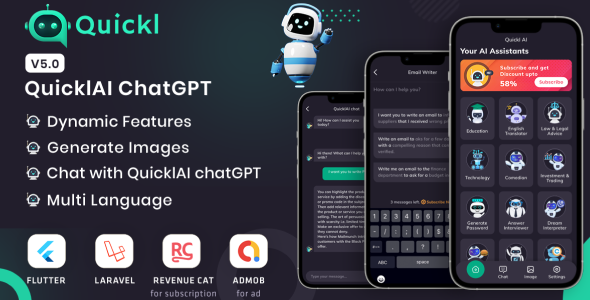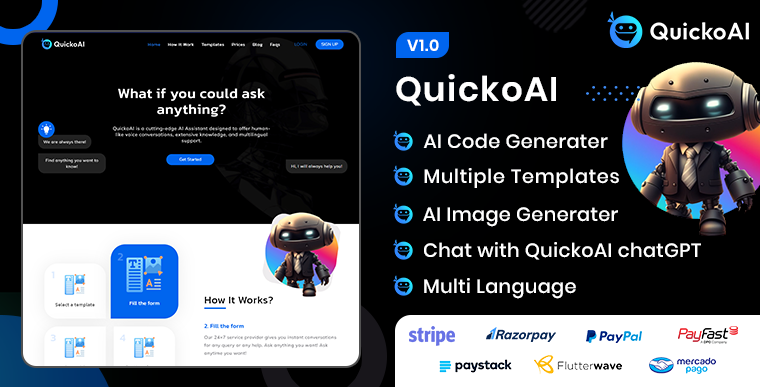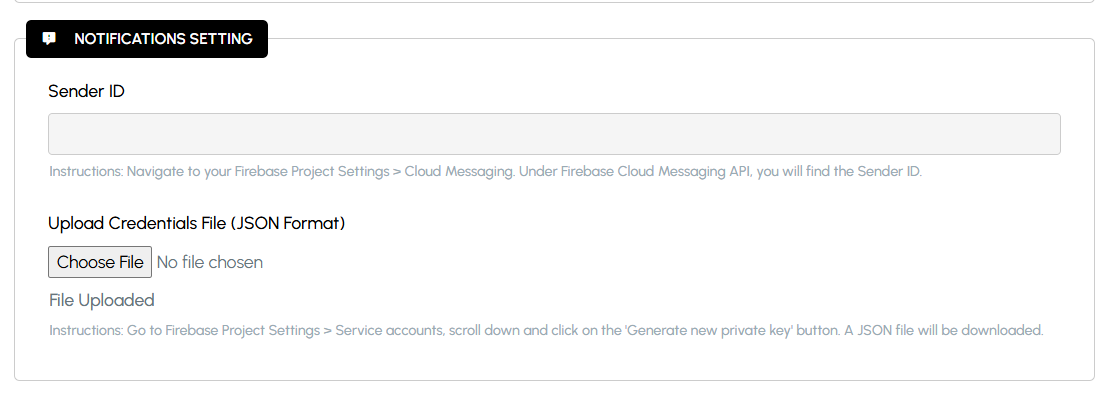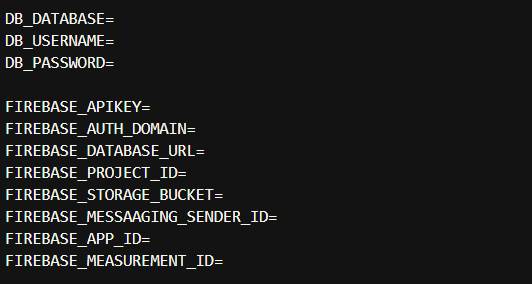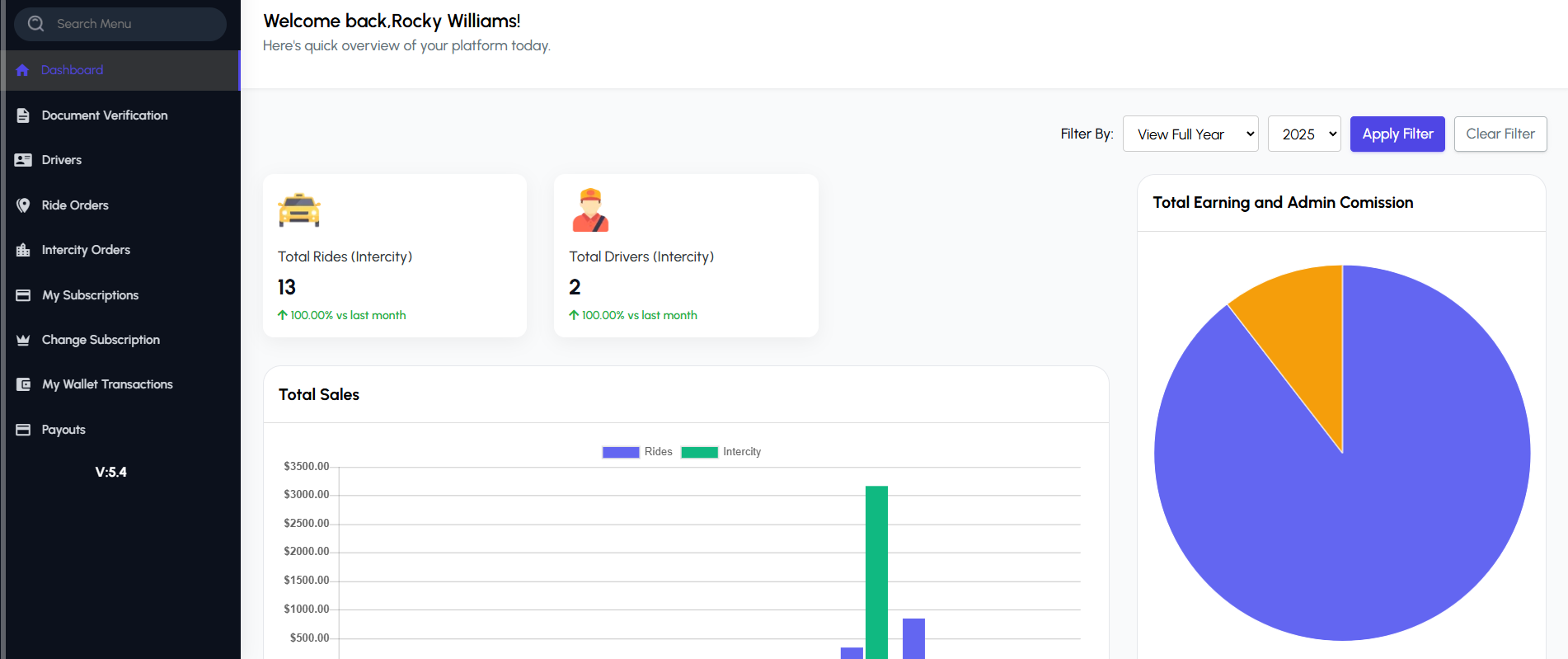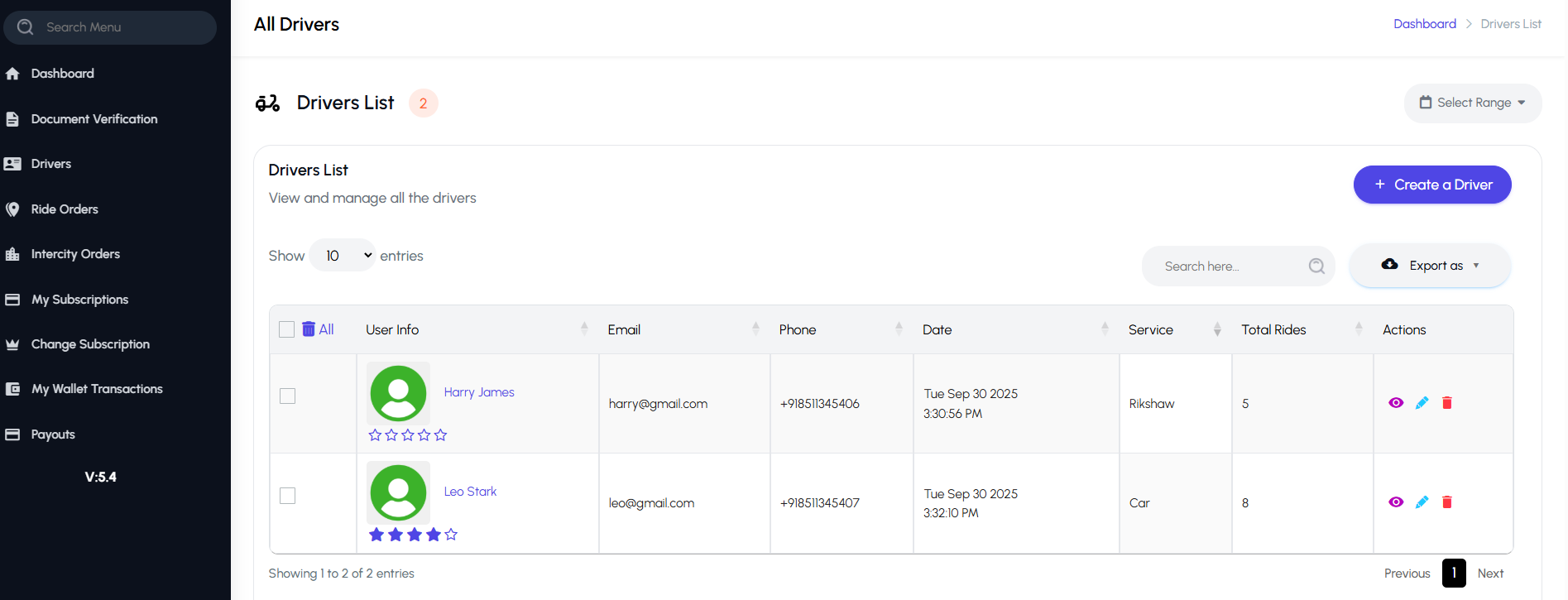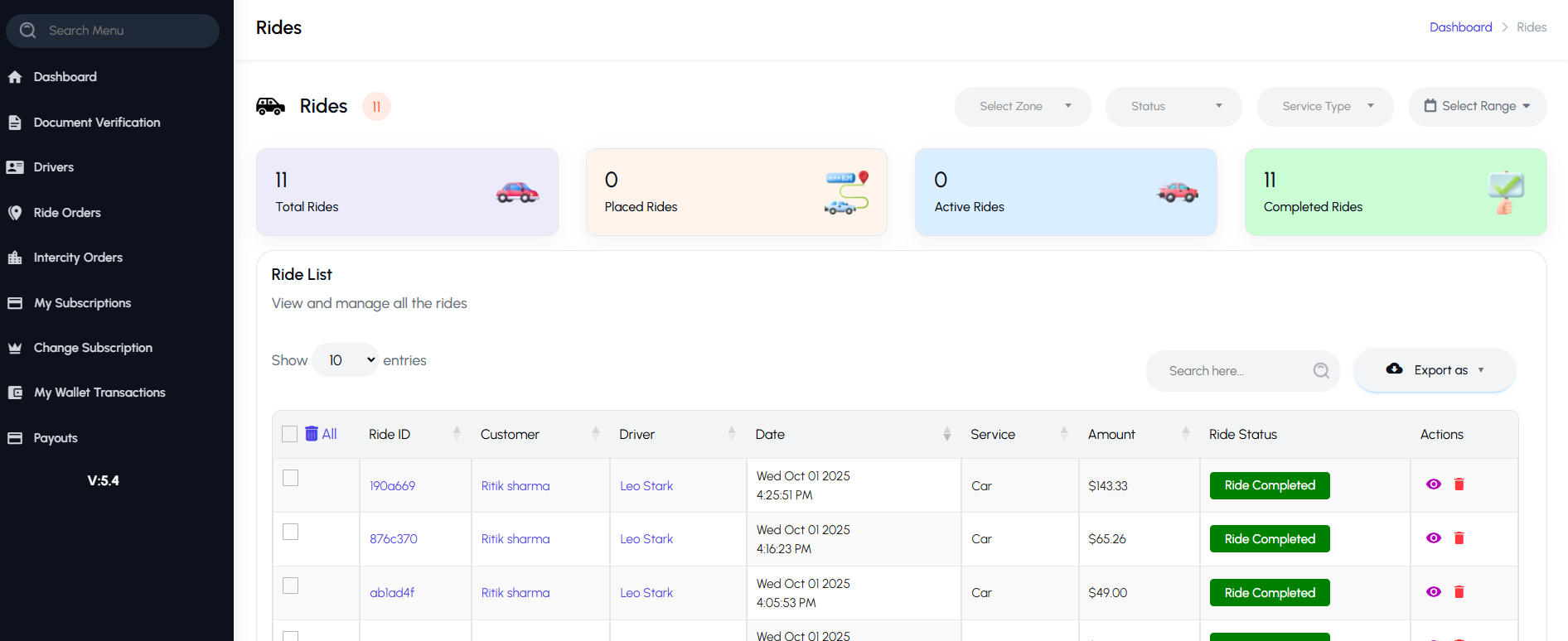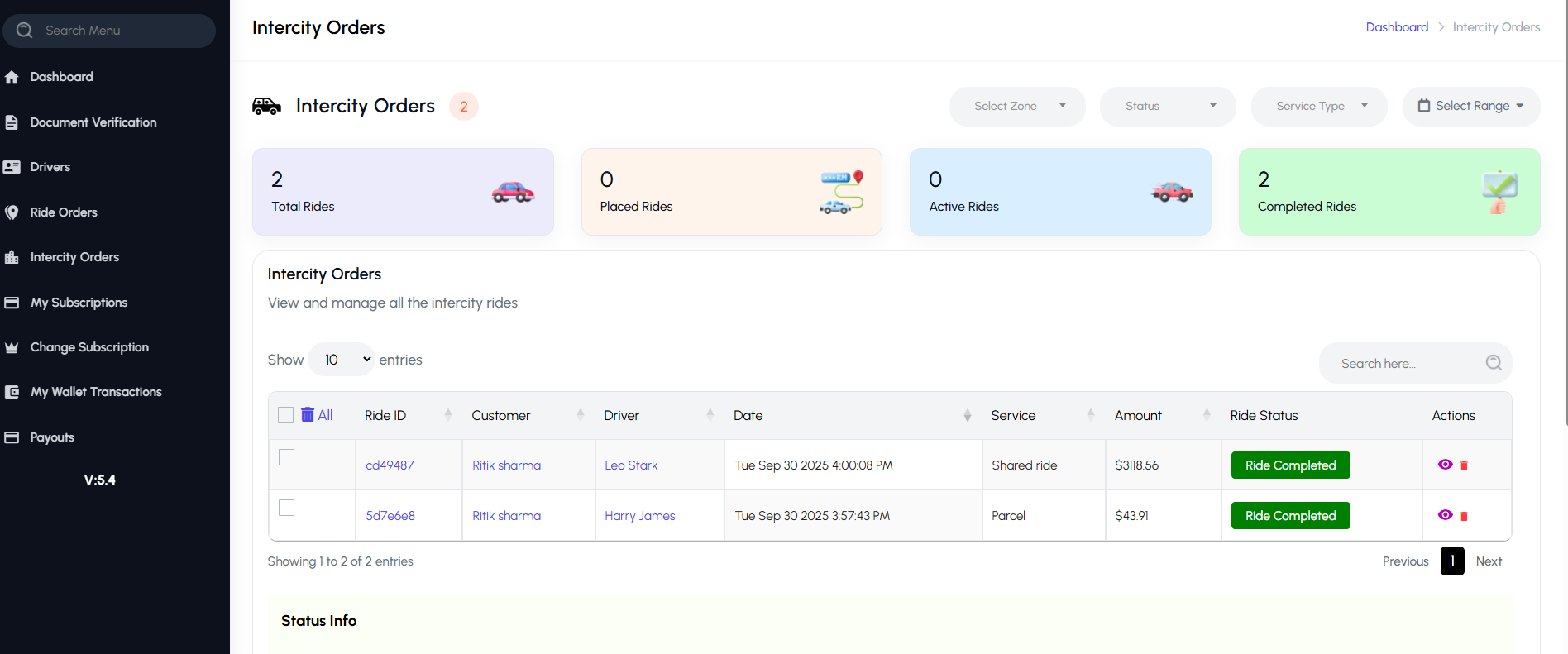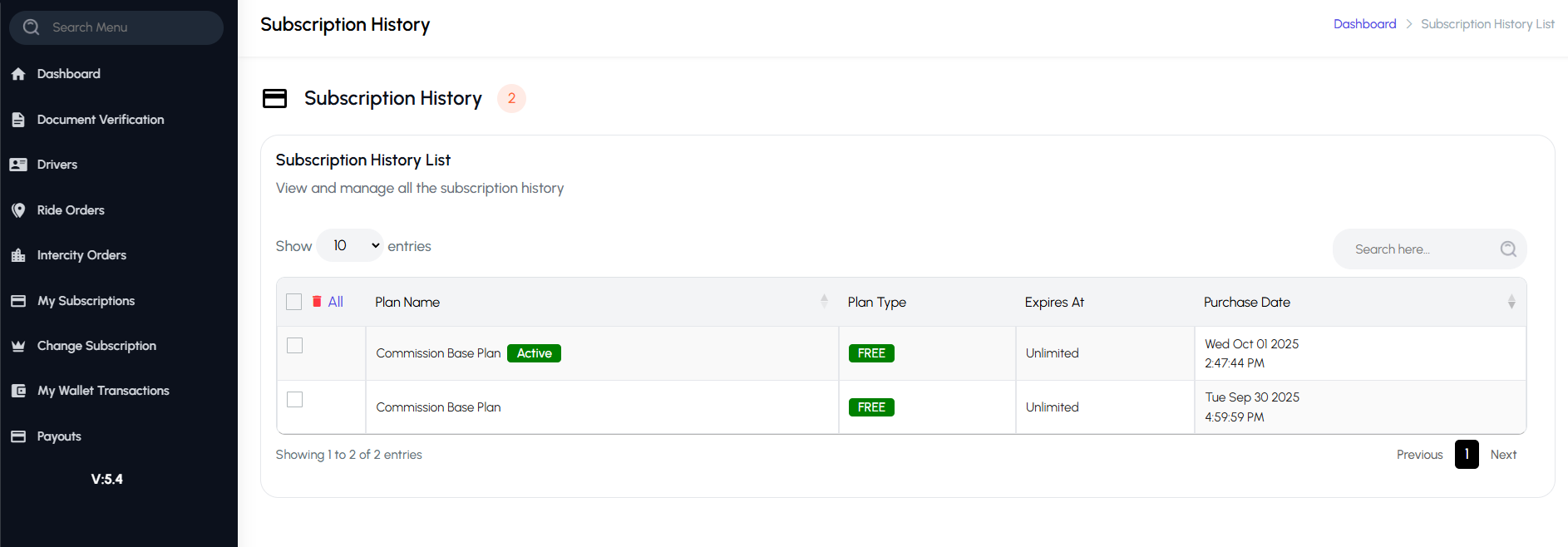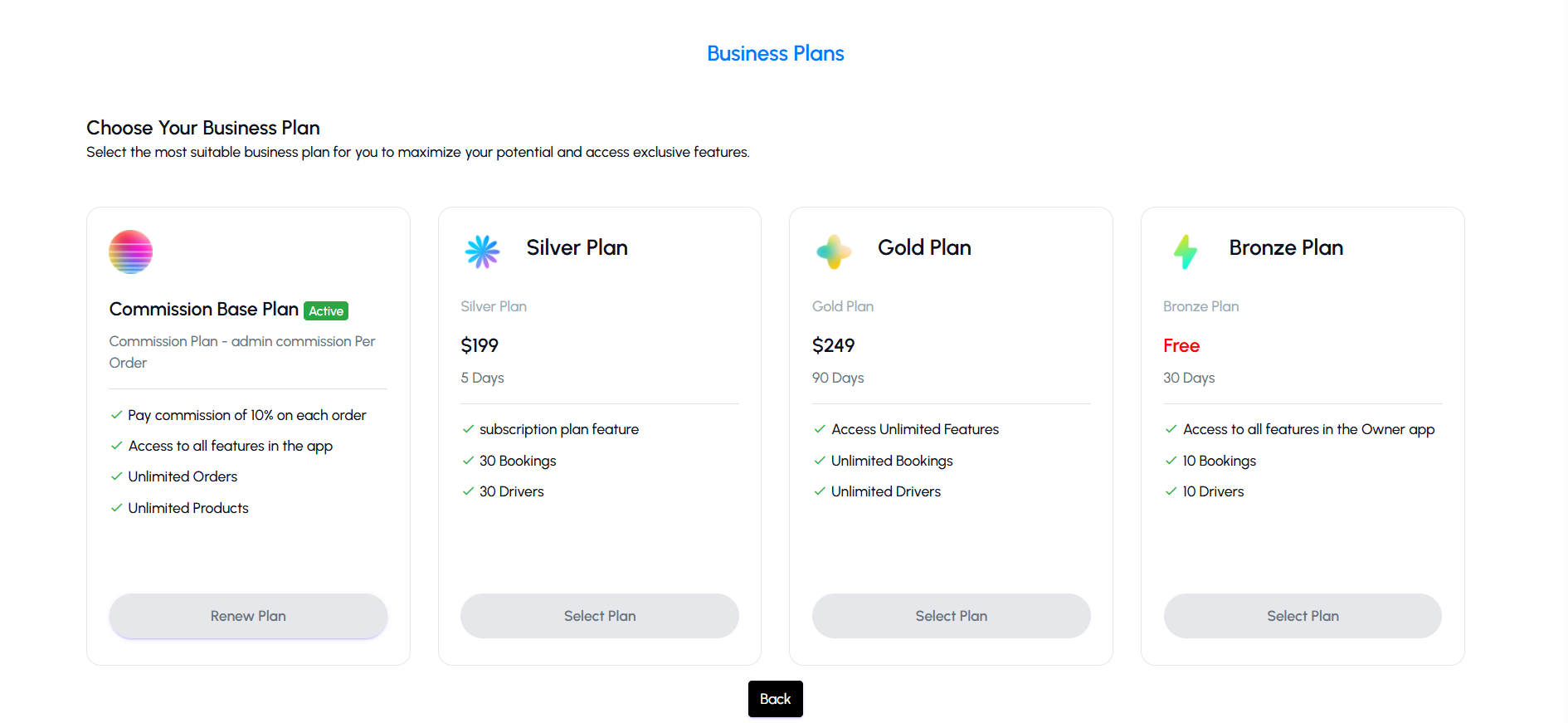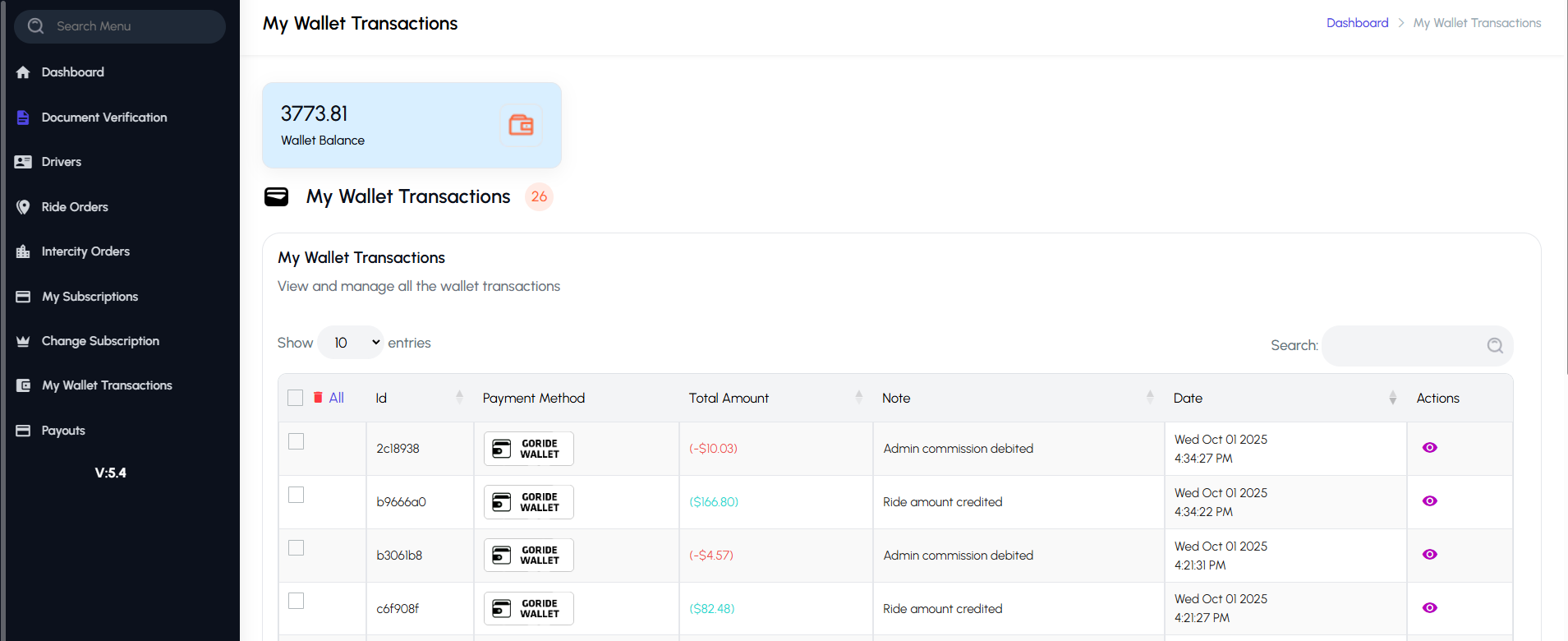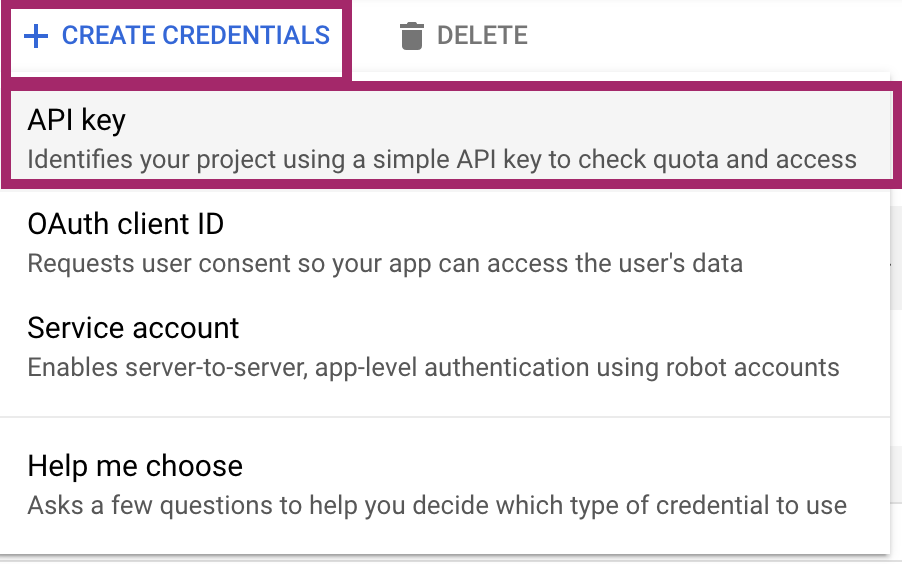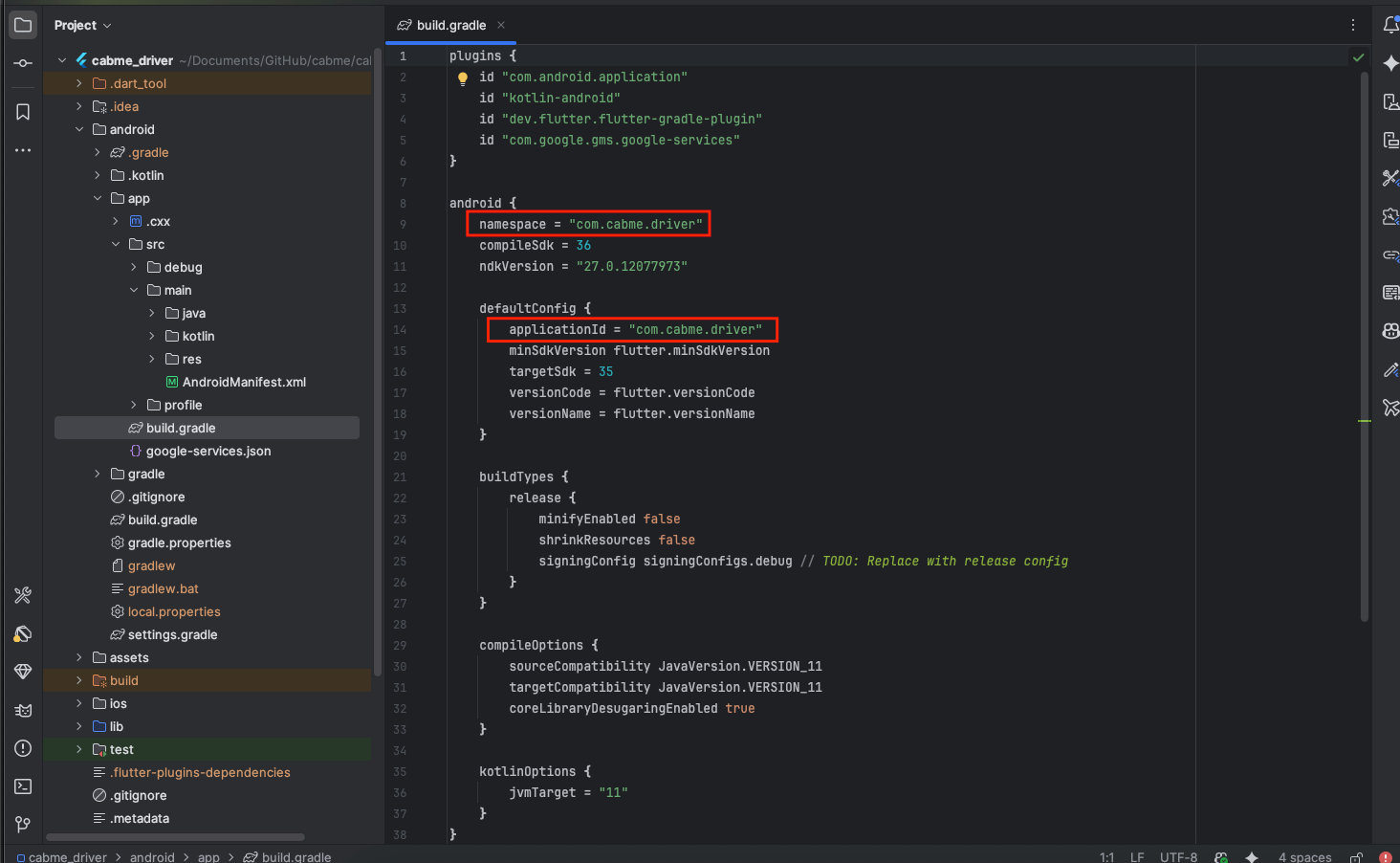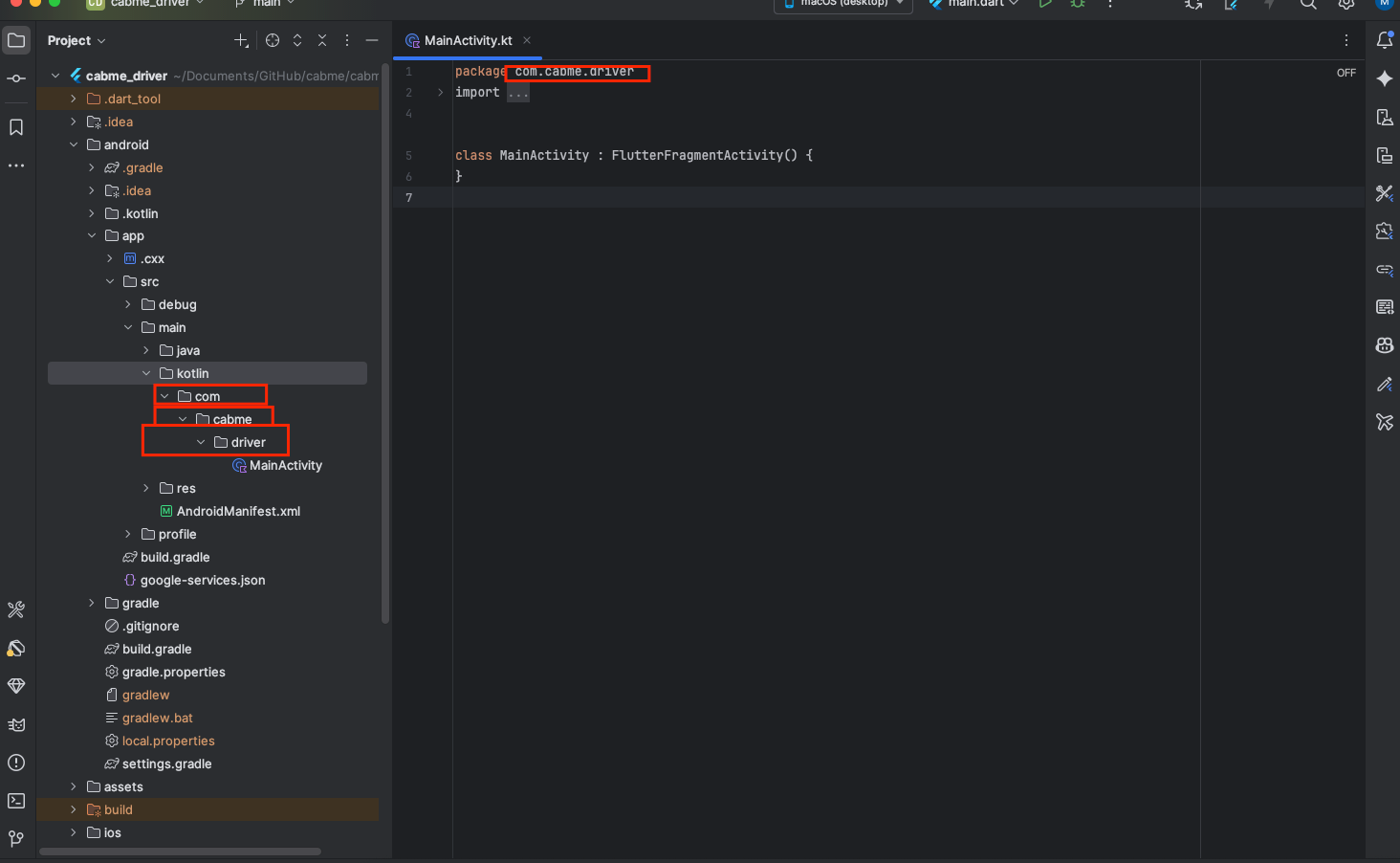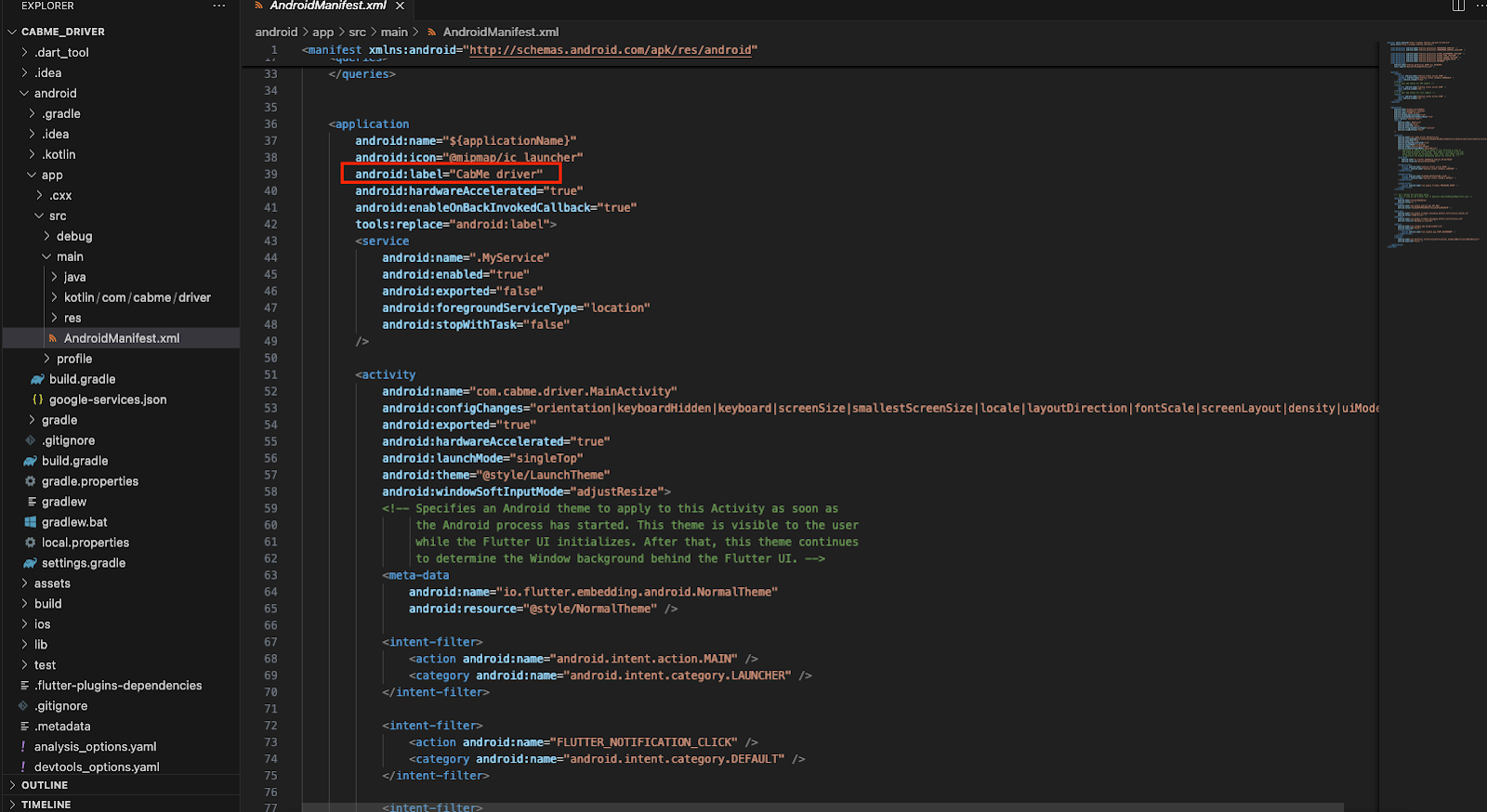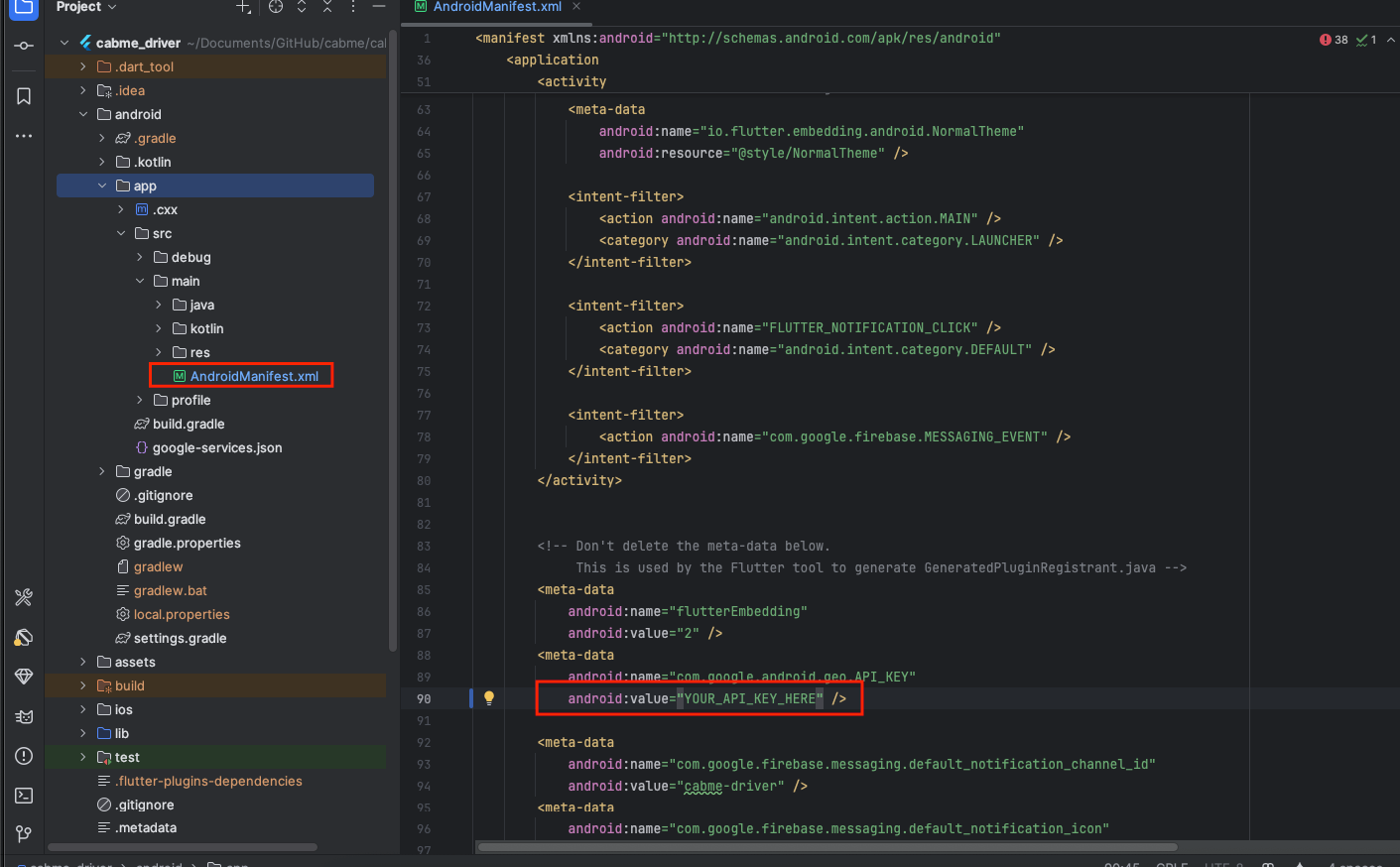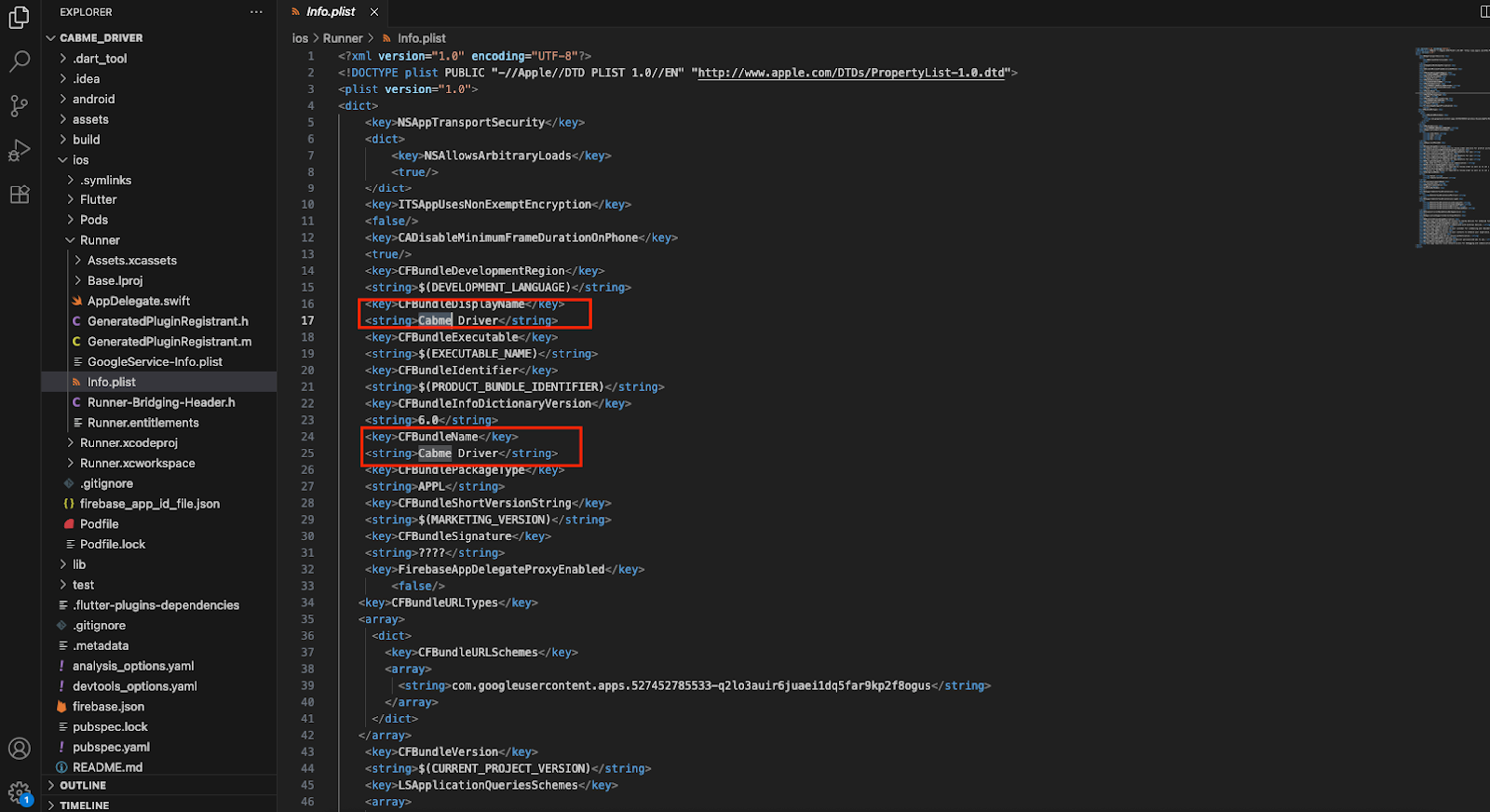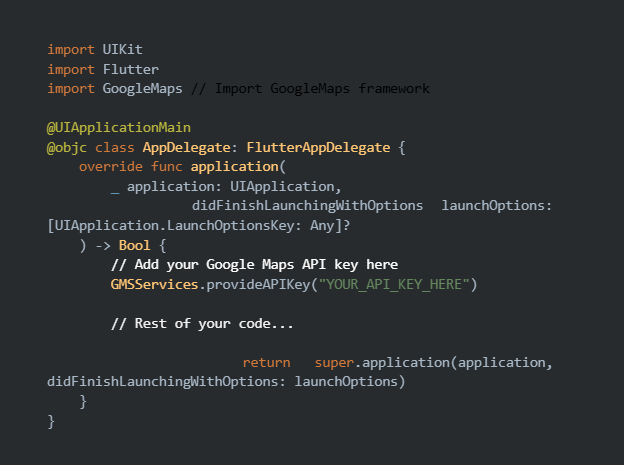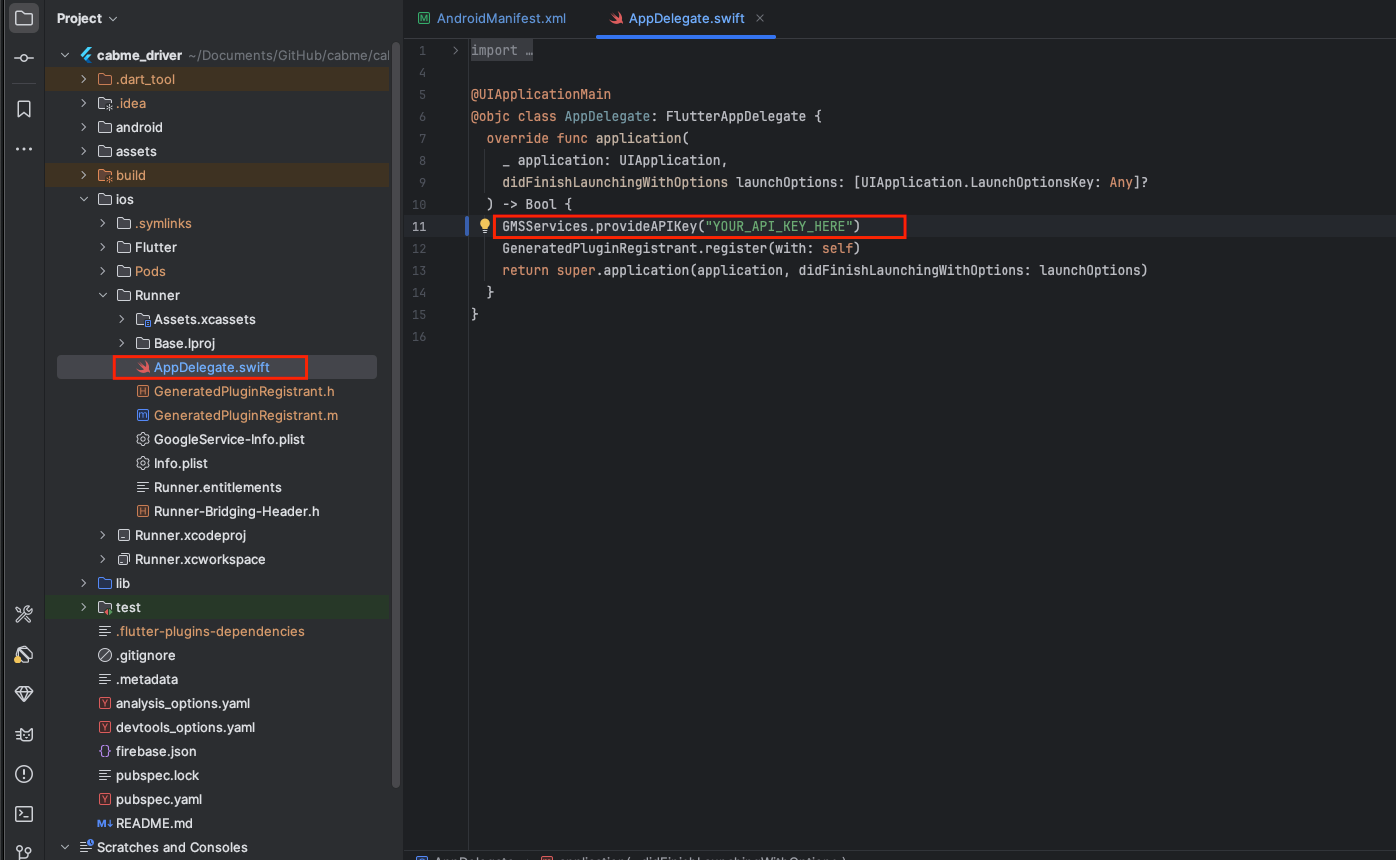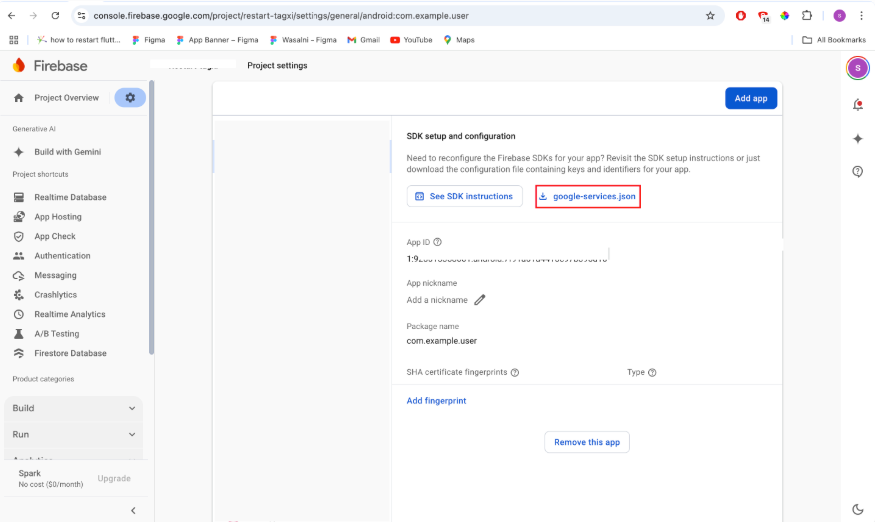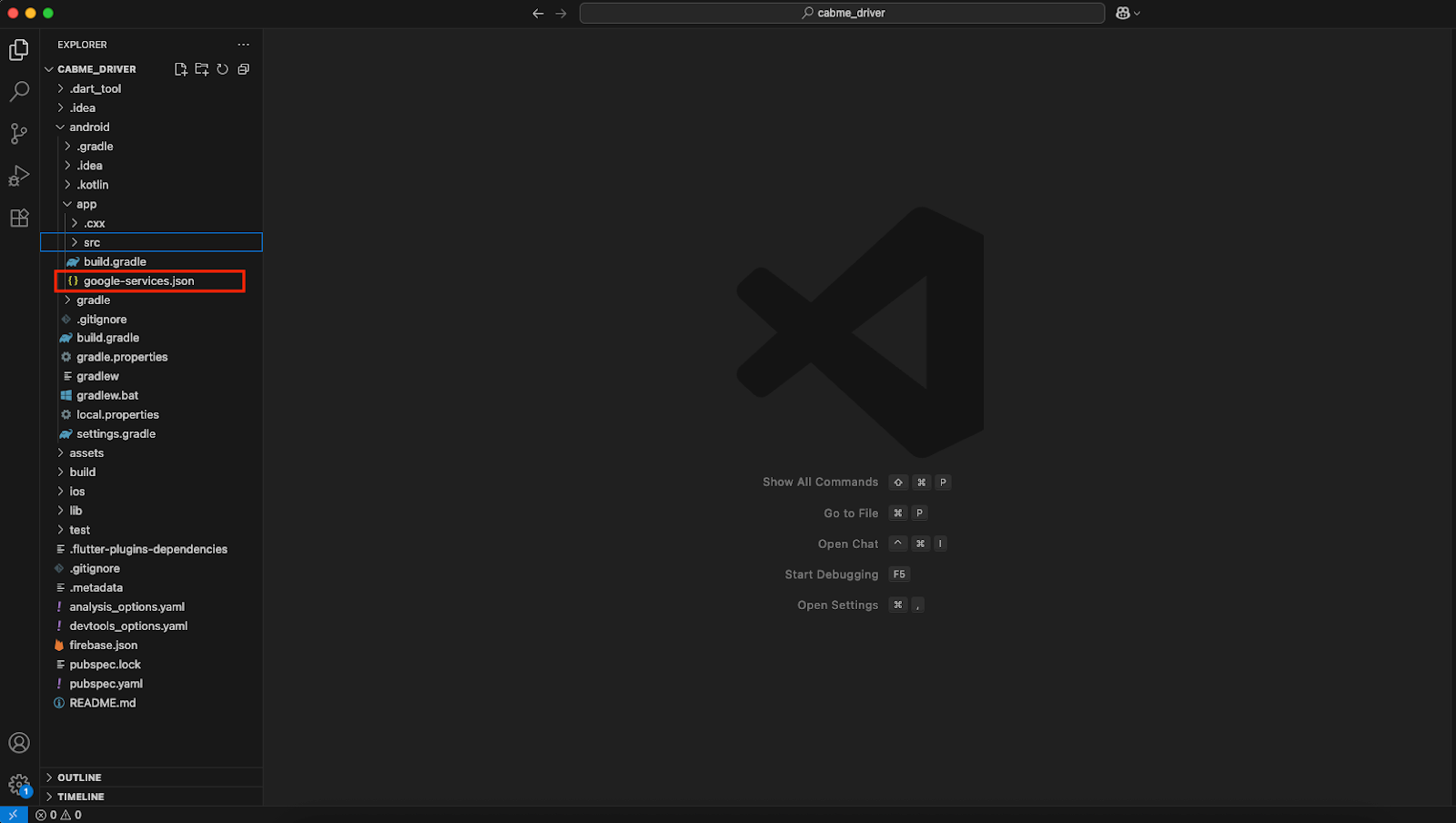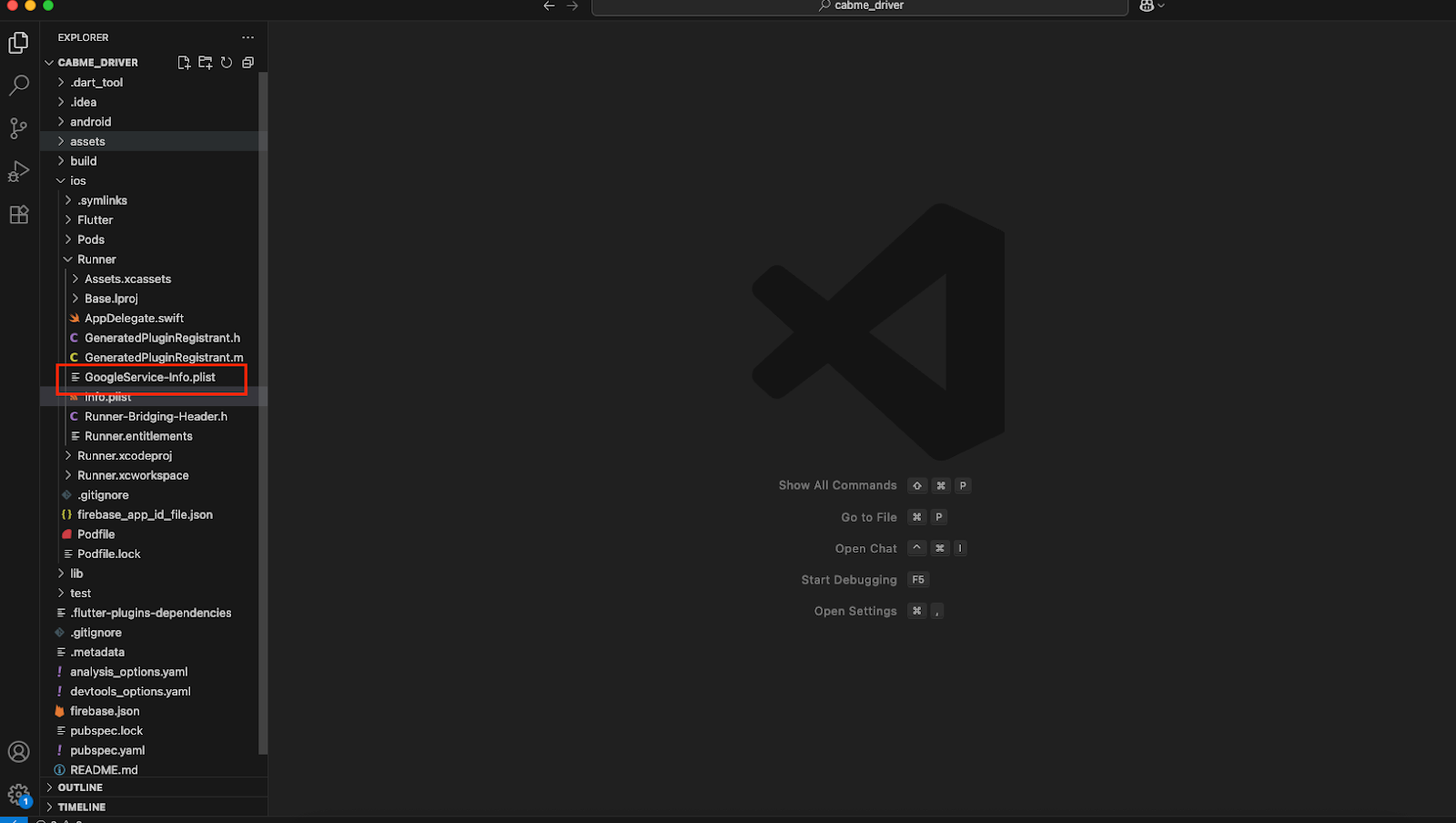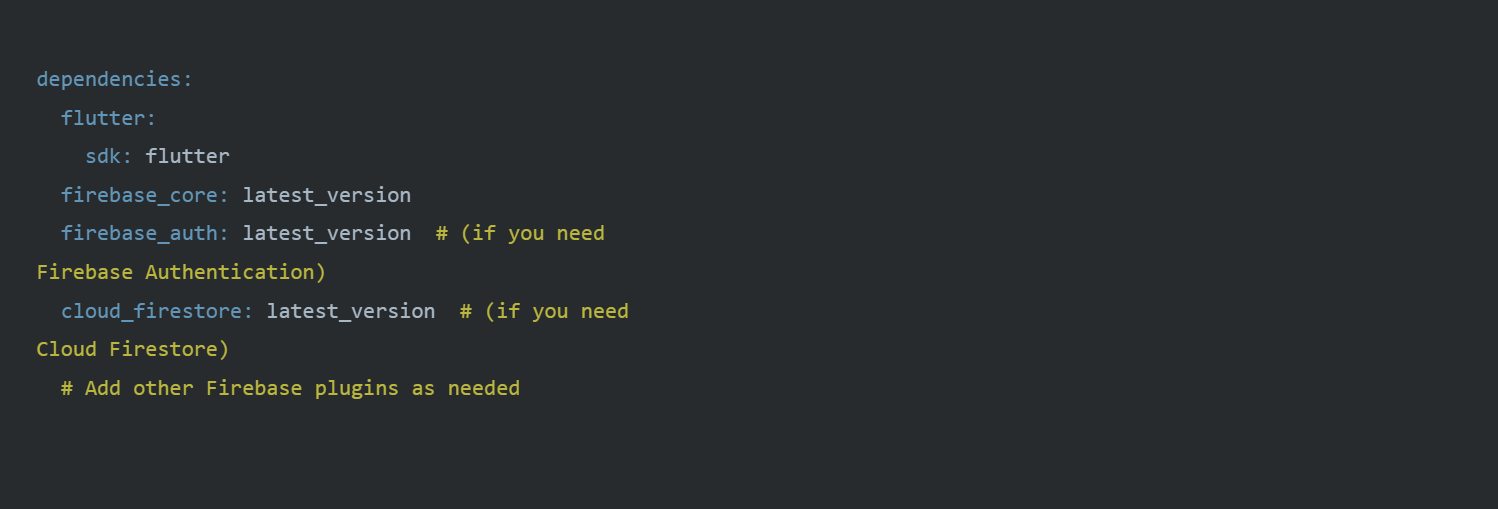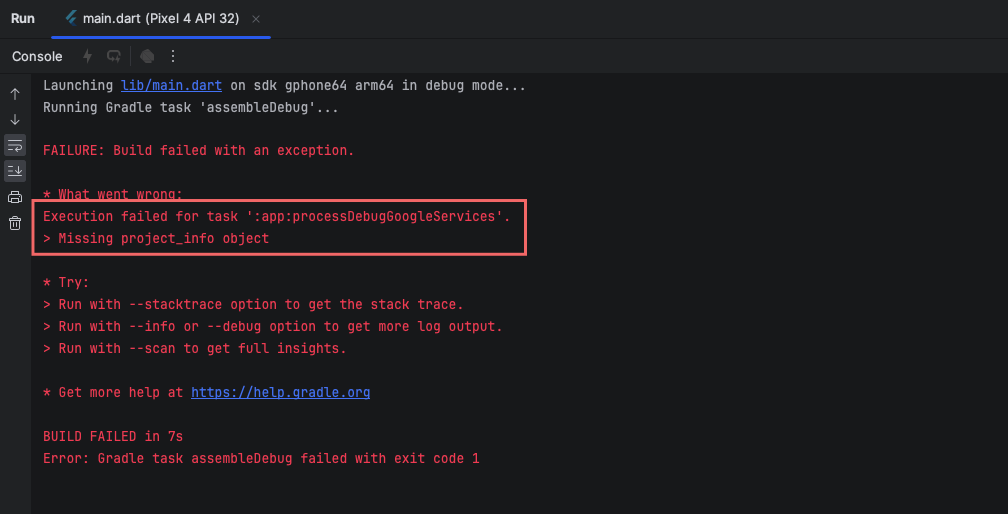5. Admin Panel Menus Overview
5.1. Dashboard
Provides an at-a-glance overview of the business. Displays analytics such as total customers, registered drivers, completed rides, latest rides, top drivers, and overall earnings overview. Helps admins quickly monitor performance.
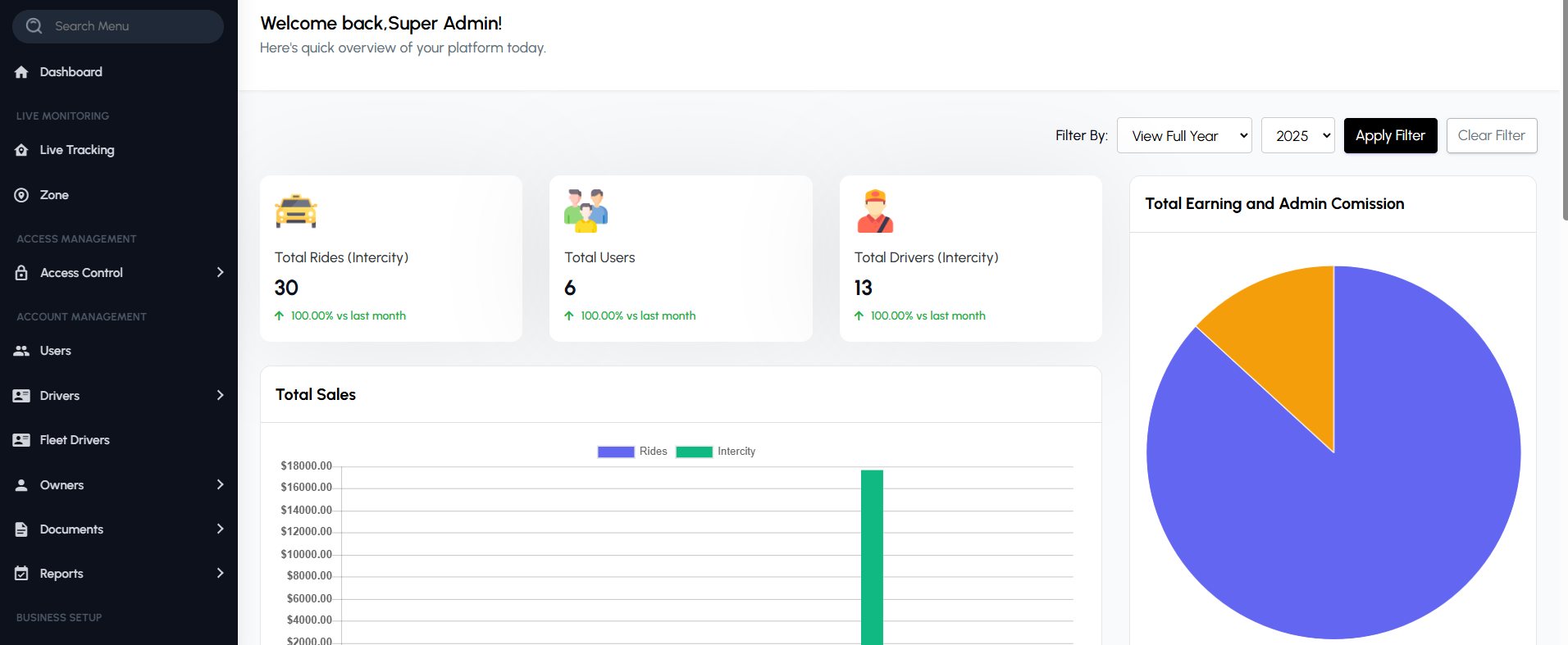
5.2. Live Monitoring
Live Tracking
Monitor drivers and vehicles in real time on the map. Useful for managing rides, ensuring driver accountability, and providing live support.
Zone
Service zones allow you to define the exact areas where your platform operates, such as specific cities, regions, or neighborhoods. Within each zone, Additionally, zone-based policies give you flexibility to apply different operational rules for each area, ensuring a more accurate, efficient, and localized service experience.

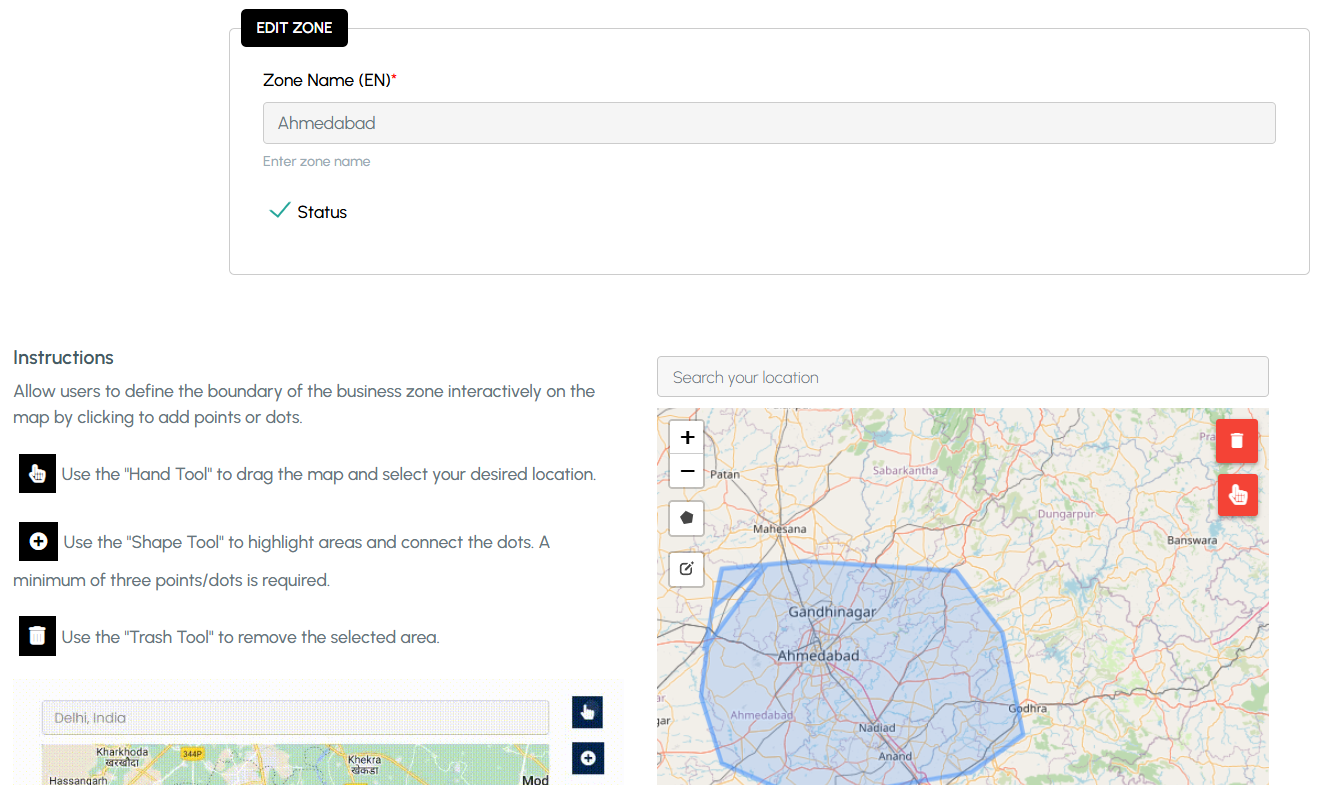
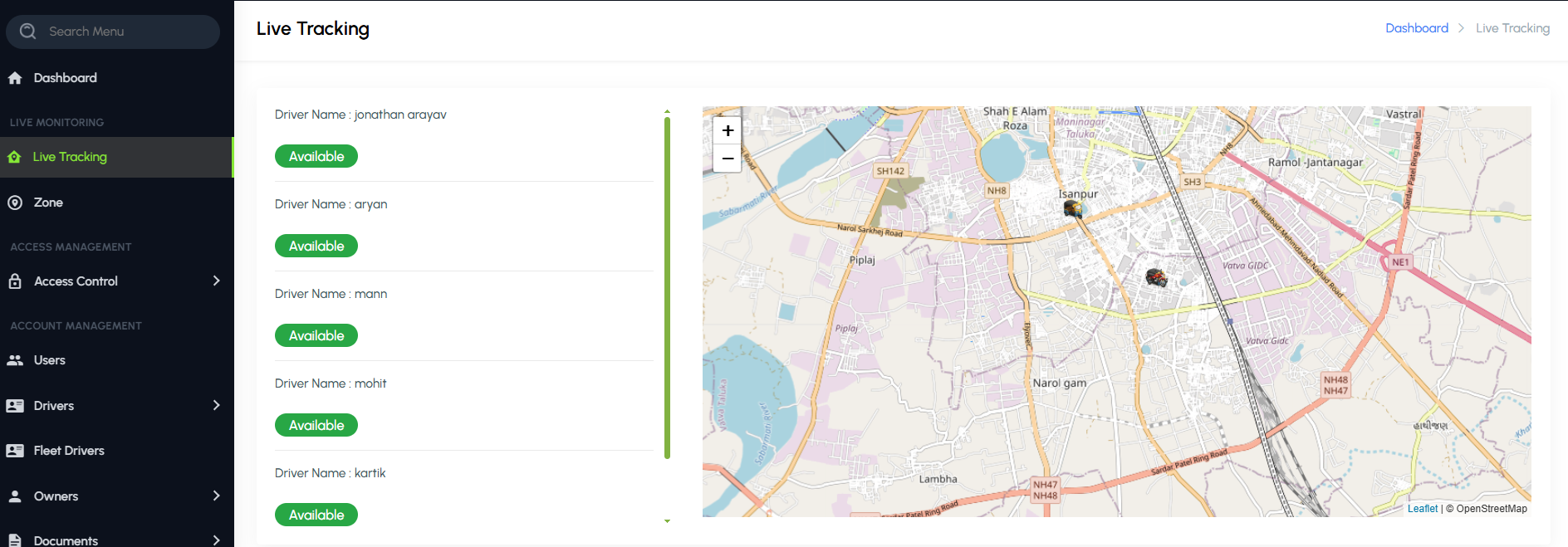
5.3. Access Management
Access Control
Create and manage admin permission groups (e.g., Super Admin, Editor, Dispatcher). Control what each admin role can view or edit within the system.

5.4. Account Management
Users
The Customers page allows administrators to view and manage all customer accounts registered through the mobile application. Each profile displays essential details such as personal information, contact data, and account status. Admins can review a customer’s complete ride history, including completed, canceled, and ongoing bookings, to monitor activity and resolve issues quickly. Ensuring better coordination and customer support. This page also provides the ability to edit or deactivate accounts, helping maintain a secure and well-managed user base.
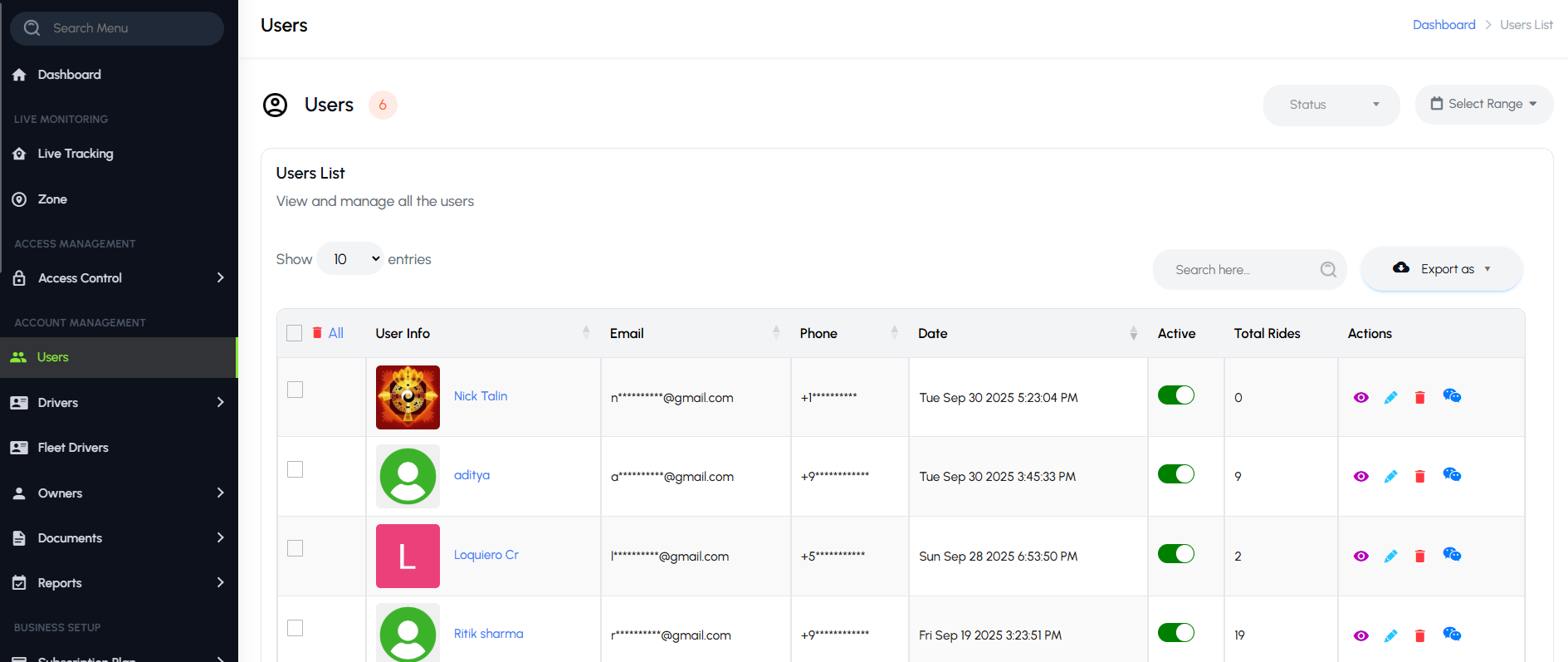
Drivers
The Drivers page provides administrators with full control over managing individual driver accounts on the platform. Each driver profile displays personal details, uploaded documents, and verification status to ensure compliance and safety. From this page, admins can review and approve driver applications, track their current availability, and monitor active or completed trips. The system also offers insights into driver earnings, commission deductions, and payout history for transparent financial management. Additionally, admins can update driver information, suspend accounts if necessary, and maintain a reliable pool of professional drivers for smooth operations.
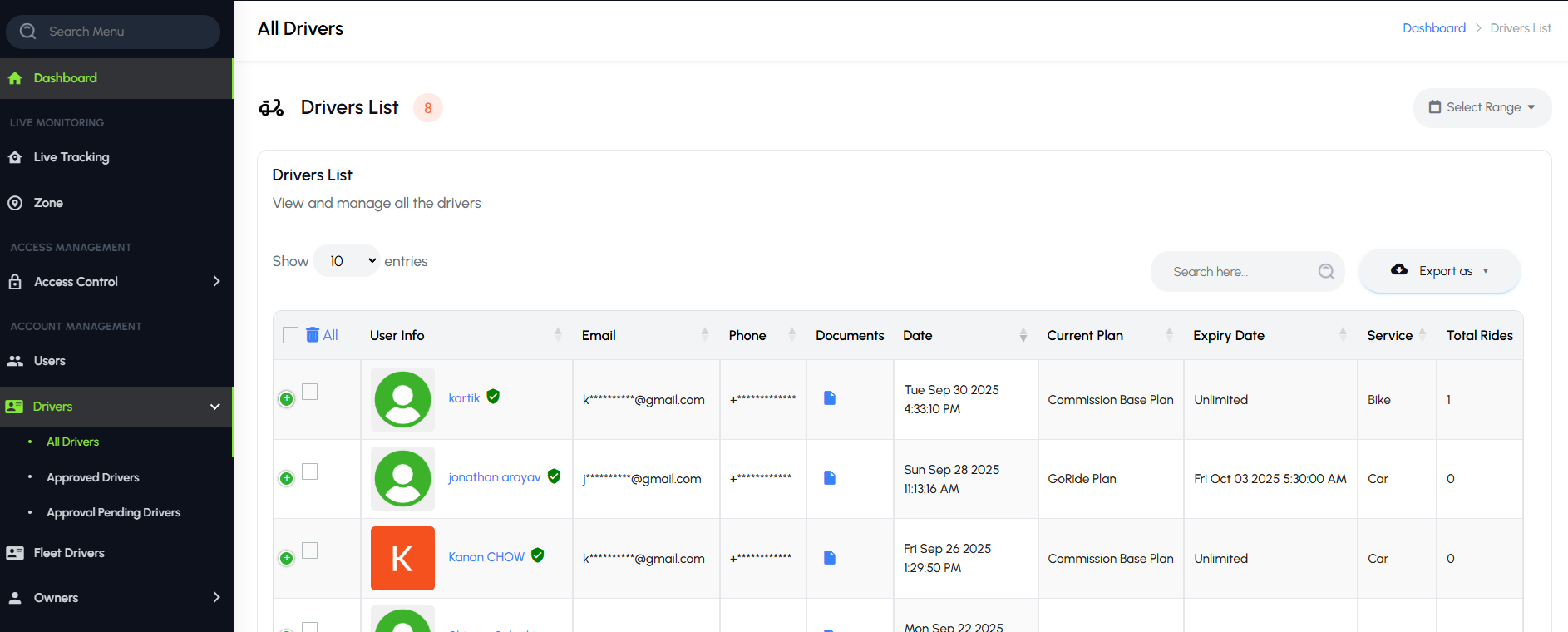
Fleet Drivers
The Fleet Drivers page is designed to manage drivers who are associated with registered fleet owners. Unlike independent drivers, these drivers operate under a specific owner’s fleet, allowing for organized group management. Administrators can view detailed profiles of fleet-linked drivers, including assigned vehicles, and ride activity. This page also provides visibility into each driver’s earnings and commission, ensuring accurate revenue tracking between drivers, fleet owners, and the platform. By centralizing fleet-based driver management, the page helps maintain accountability and smooth coordination within larger transportation networks.
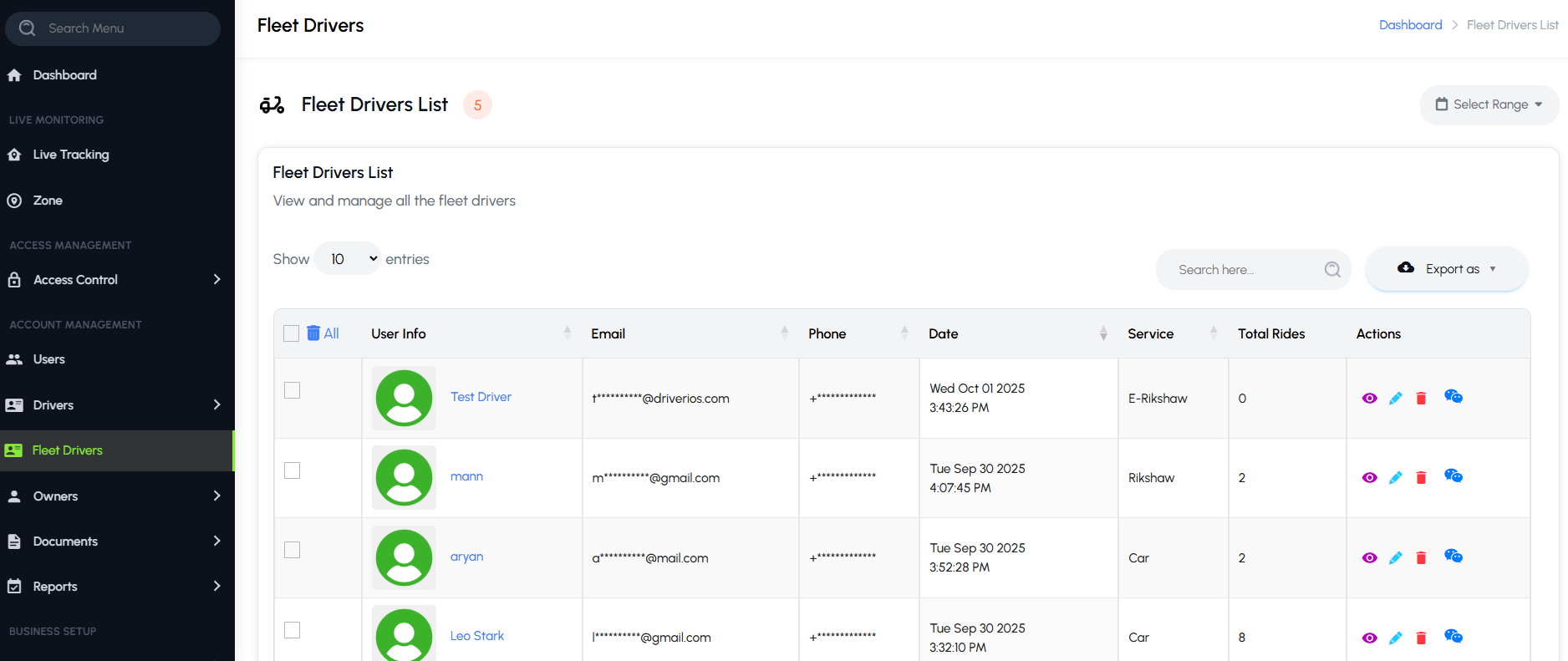
Owners
The Owners page allows administrators to manage fleet owners who register and oversee multiple drivers and vehicles within the platform. Each owner profile includes essential details such as contact information, registered vehicles, and assigned drivers. Admins can monitor the performance of each fleet, including trip activity, availability, and vehicle status. The page also provides a breakdown of owner earnings, platform commission, and payout history, ensuring financial transparency. With this centralized view, administrators can easily track fleet operations, resolve issues, and maintain strong relationships with fleet partners.
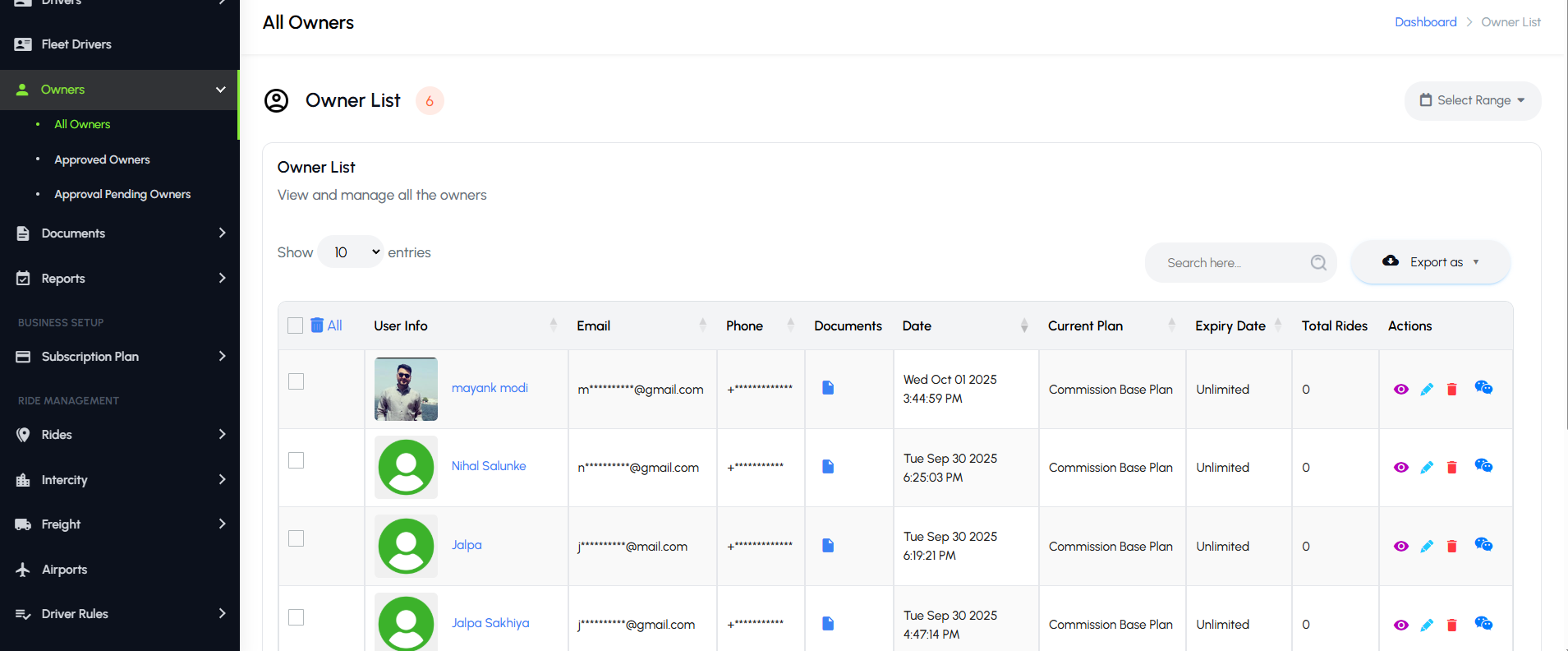
Documents
The Driver Documents page allows administrators to define and manage the documents required for verification of individual drivers and fleet owners. Admins can add new document types, such as Aadhaar Card, PAN Card, Driver License, or other ID proofs, and specify which documents must be uploaded during verification. This ensures that all necessary documentation is collected to maintain compliance, authenticity, and safety on the platform.
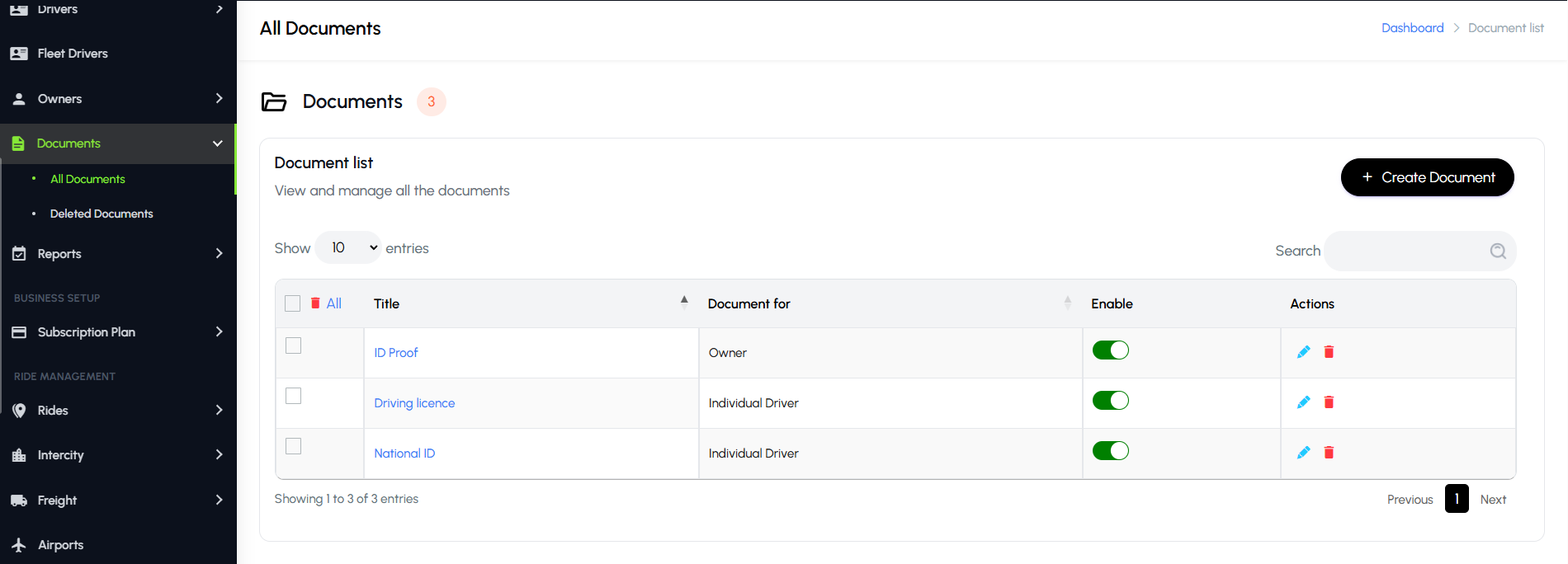
Reports
The Reporting and Analytics section in the admin panel provides comprehensive insights into platform activity, allowing administrators to monitor performance, make data-driven decisions, and identify trends. Reports can be customized using various filters and options to generate precise and actionable information. Key options include:
Status: Filter reports by the status of rides, trips, or transactions (e.g., completed, canceled, ongoing).
Date Options: Quickly generate reports based on preset time frames like Today, This Week, This Month, or This Year.
File Format: Export reports in multiple formats such as XLS, CSV, or PDF for offline analysis, record-keeping, or sharing with stakeholders.
User Reports
The User Reports page generates detailed reports on customer activity. Administrators can track metrics such as ride history, active and canceled bookings, wallet usage, and promotional coupon redemptions. This helps identify user engagement patterns, monitor retention, and address issues impacting the customer experience.

Driver Reports
The Driver Reports page focuses on driver performance analytics. Admins can review completed trips, acceptance and cancellation rates, earnings, ratings, and feedback. These reports help evaluate driver efficiency, reward top performers, and take corrective actions for underperforming drivers, ensuring high service quality.

Ride Reports
The Travel Reports page consolidates analytics across all service types — rides. It provides insights into total revenue, number of trips, cancellations, average trip distance, and peak usage times. This data helps in resource planning, optimizing service availability, and identifying high-demand periods to enhance operational efficiency.
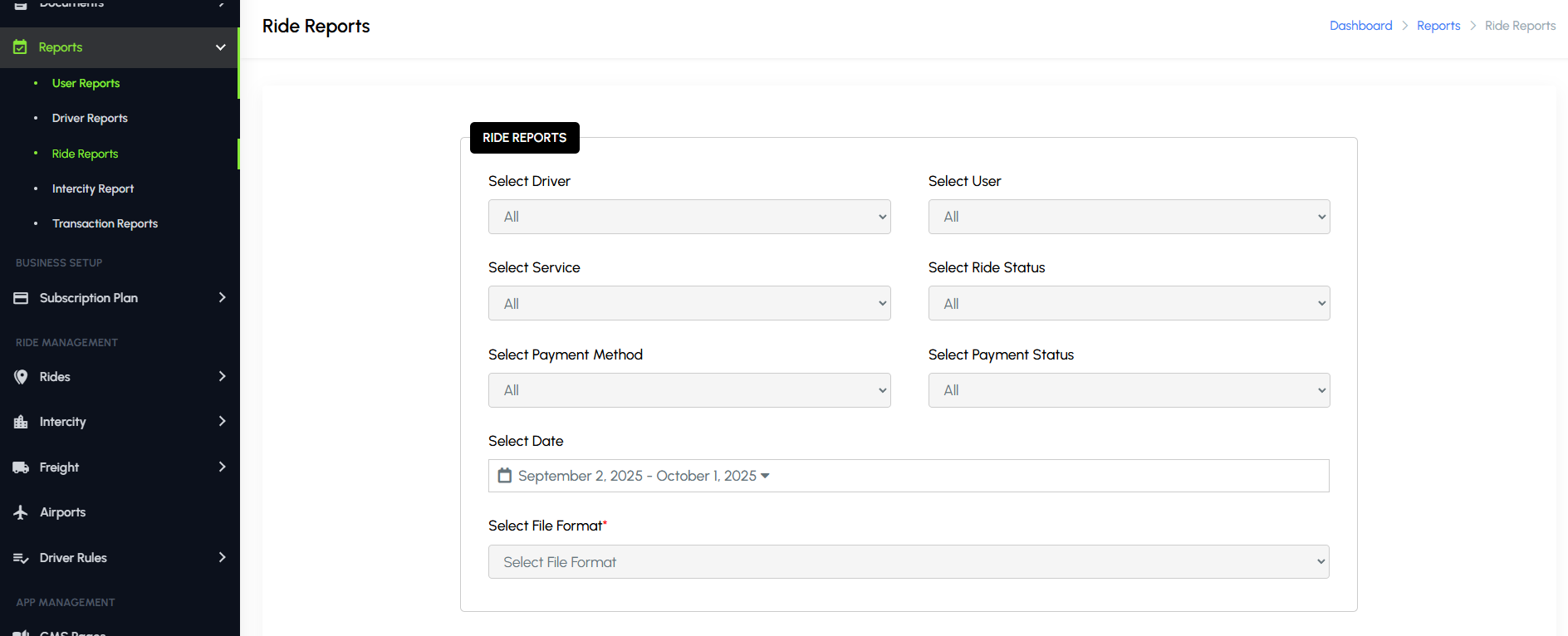
Intercity Reports
The Intercity Ride Reports page consolidates analytics specific to outstation trips. It provides insights into total intercity revenue, number of completed trips, cancellations, average trip distance, driver performance, and most popular city-to-city routes. This data helps in demand forecasting, optimizing route availability, adjusting pricing strategies, and ensuring better driver allocation for long-distance travel.
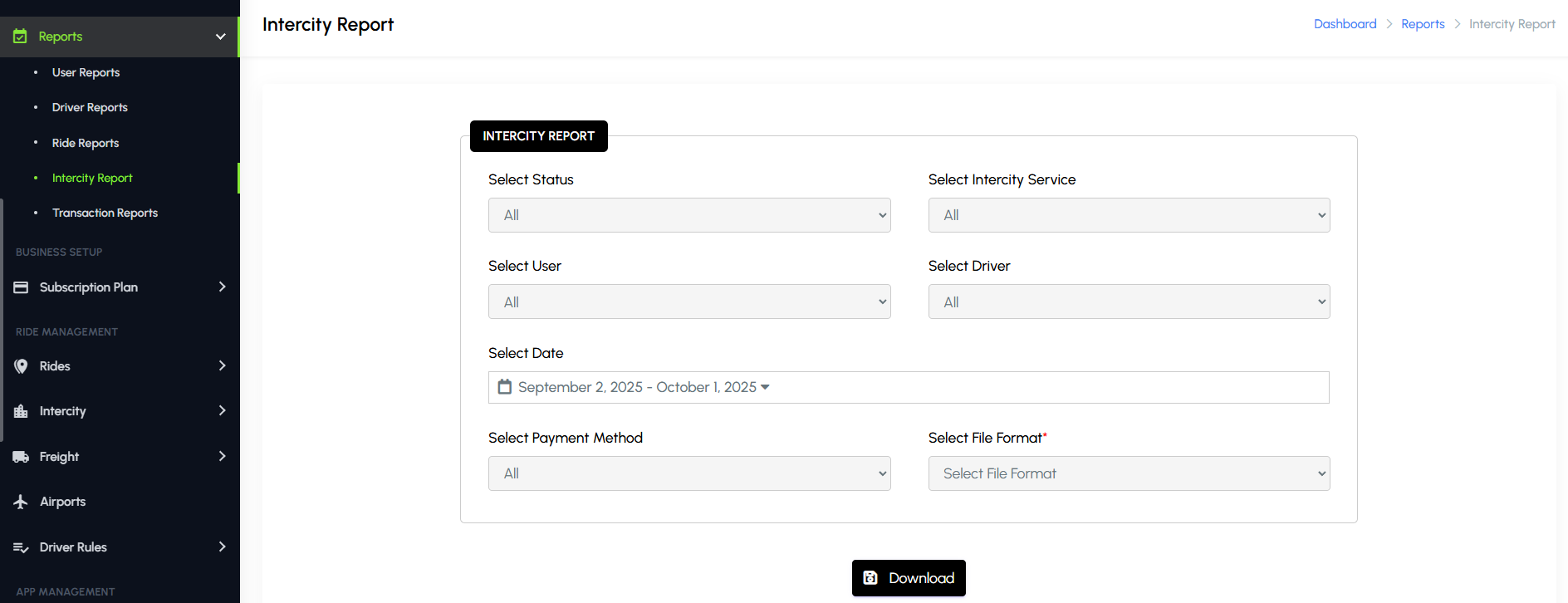
Transaction Reports
The Transaction Reports page provides a comprehensive view of all financial activities across the platform. It tracks completed payments, pending transactions, refunds, discounts, commissions, and wallet activity. This data helps in monitoring revenue flow, reconciling accounts, identifying payment trends, and ensuring financial transparency between riders, drivers, and the platform.
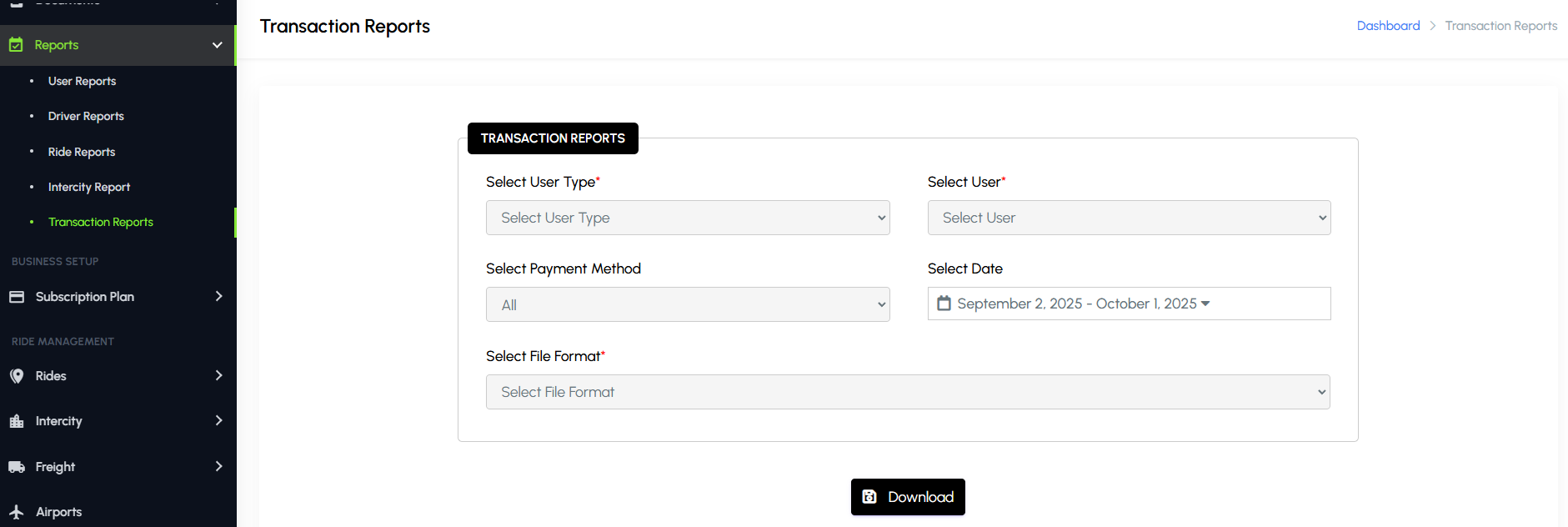
5.5. Business Setup
Subscription Plan
The Subscription Plan page allows administrators to create and manage subscription packages for drivers and fleet owners. These plans define recurring fees that drivers or owners pay to access the platform’s services, replacing or supplementing commission-based models. Each plan can include details such as pricing, billing cycle (weekly, monthly, yearly), benefits, and usage limits. Admins can track which drivers or owners are subscribed, monitor their subscription history & payment status.
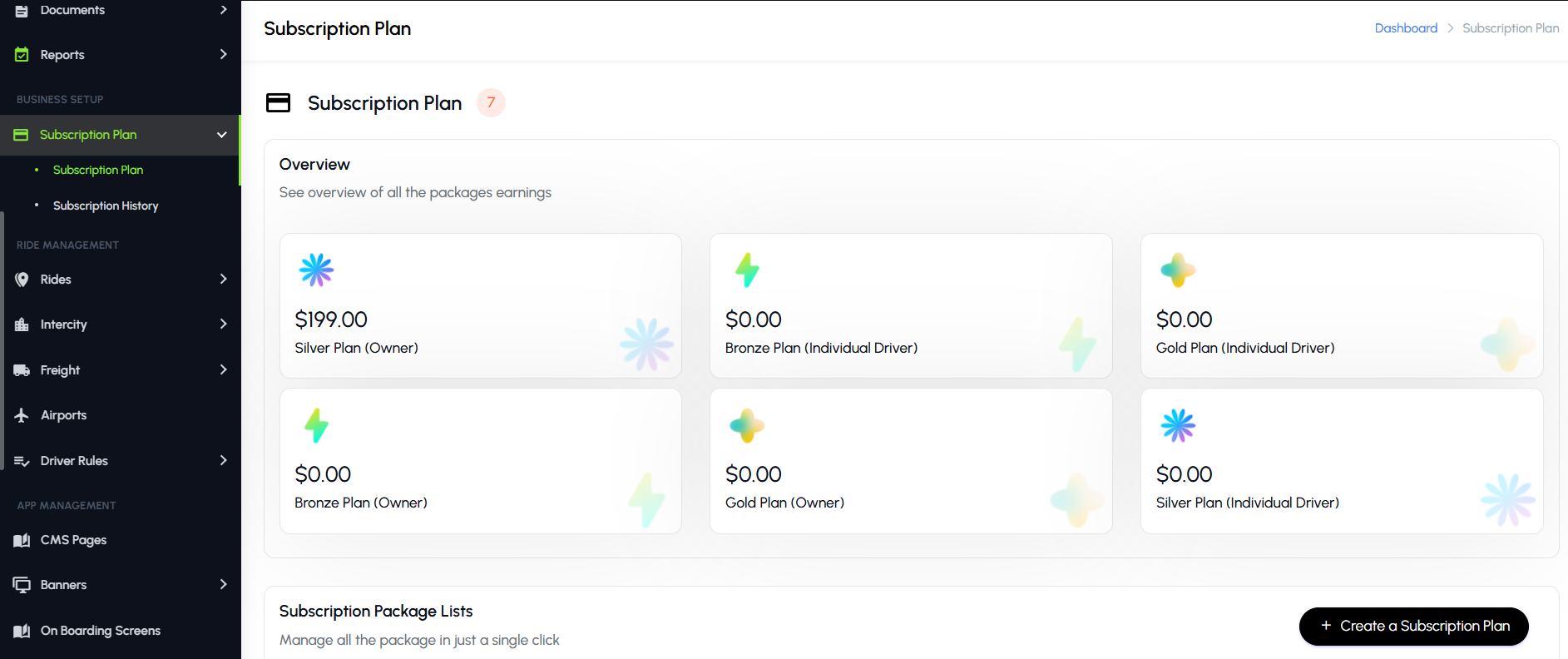
5.6. Ride Management
Rides > Services
The services page allows administrators to define and manage multiple ride categories such as Car, Rickshaw, and Bike. It provides flexibility to add, edit, or disable service types based on market demand. This helps in offering diverse transportation options to riders, ensuring better coverage of customer needs, and optimizing fleet allocation for each service category.
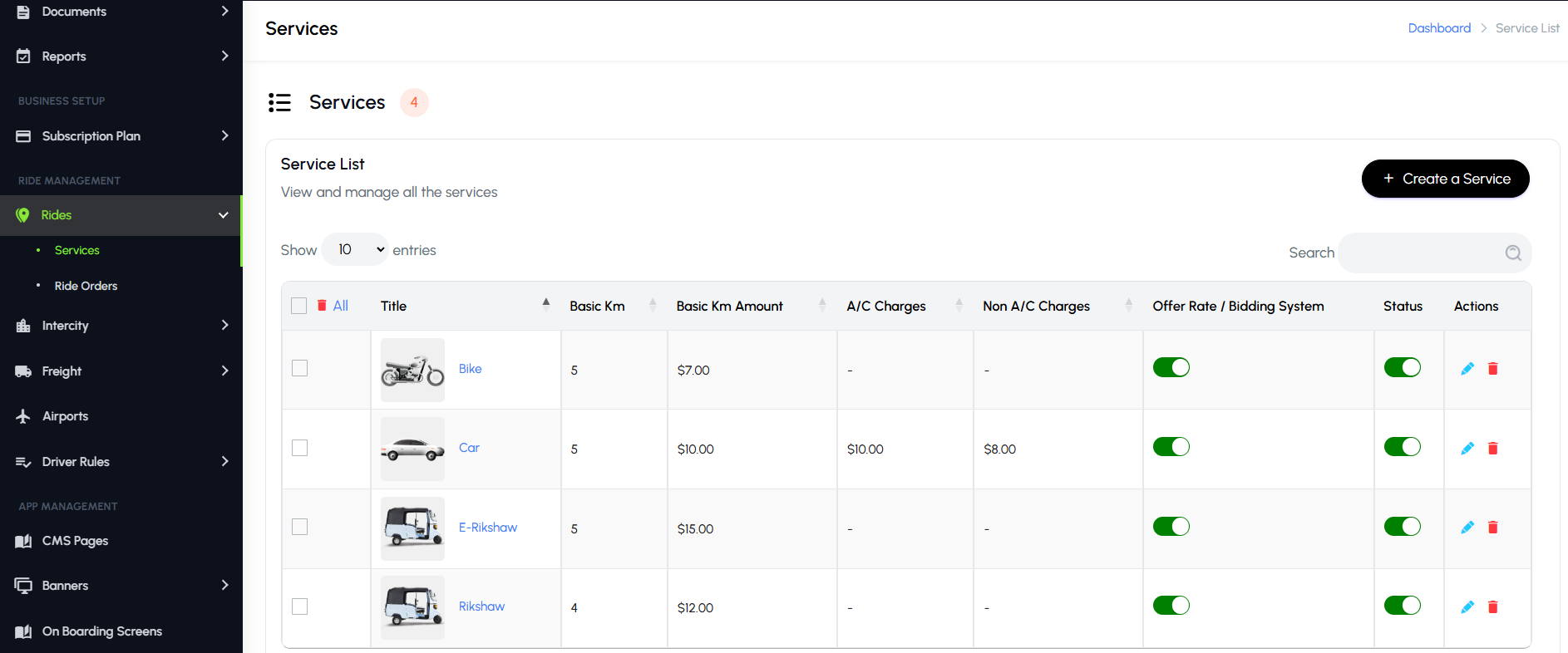
Rides > Ride Orders
The Ride Orders page provides a detailed view of all ride bookings made through the platform. It includes essential information such as booking ID, rider details, driver assignment, trip status, fare amount, payment method, and timestamps. Administrators can monitor active, completed, and cancelled rides in real-time, resolve disputes, and ensure smooth ride operations. This helps in maintaining transparency, improving service quality, and optimizing the overall ride management process.
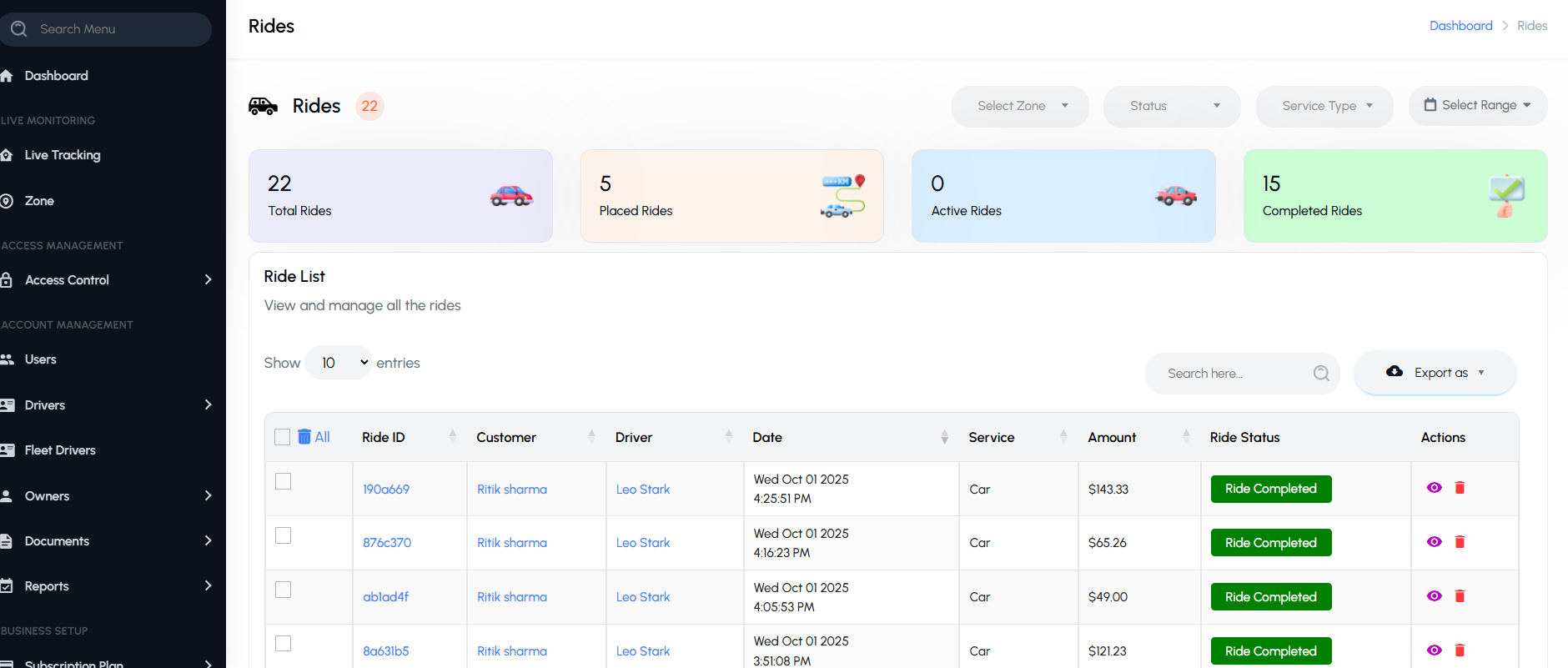
Intercity > Intercity Service
Services page enables administrators to manage different outstation service categories such as Freight, Parcel, Private Ride, and Shared Ride. Each service type can be customized with specific pricing models, vehicle requirements, and availability settings. This flexibility allows businesses to cater to diverse customer needs—whether it’s transporting goods, sending parcels, booking exclusive private rides, or offering cost-effective shared travel options across cities.
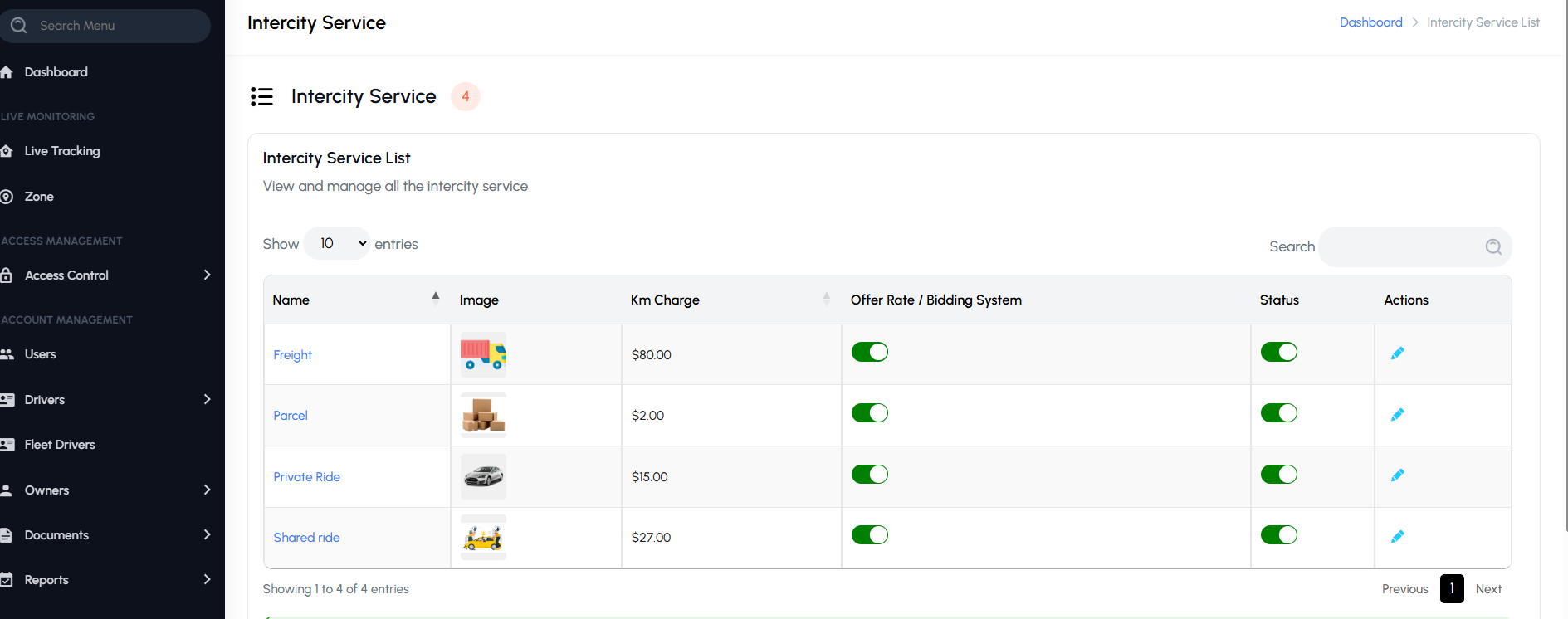
Intercity > Intercity Orders
The Intercity Orders page provides a comprehensive overview of all outstation trip bookings. It displays booking ID, passenger details, selected service type (Freight, Parcel, Private Ride, or Shared Ride), driver assignment, trip status, fare breakdown, and payment information. Administrators can track ongoing, completed, and cancelled intercity rides in real-time, manage disputes, and ensure reliable service delivery. This module helps maintain transparency, optimize long-distance operations, and improve customer satisfaction for intercity travel.
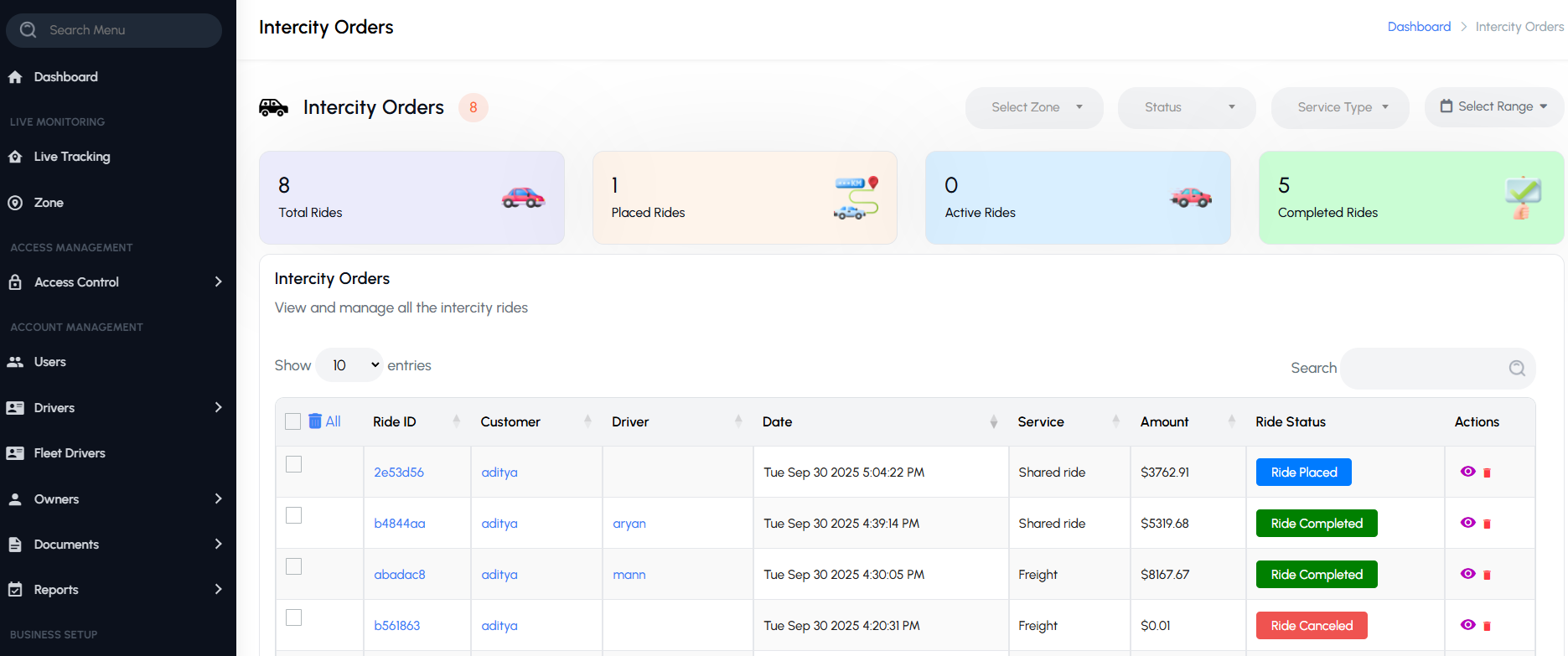
Freight
Freight Vehicle management enables administrators to define and oversee vehicles used for transporting goods. It includes details like vehicle type, load capacity, size specifications, availability, and driver assignment. This ensures efficient allocation of resources, optimized freight operations, and reliable service for businesses and customers needing goods transport.
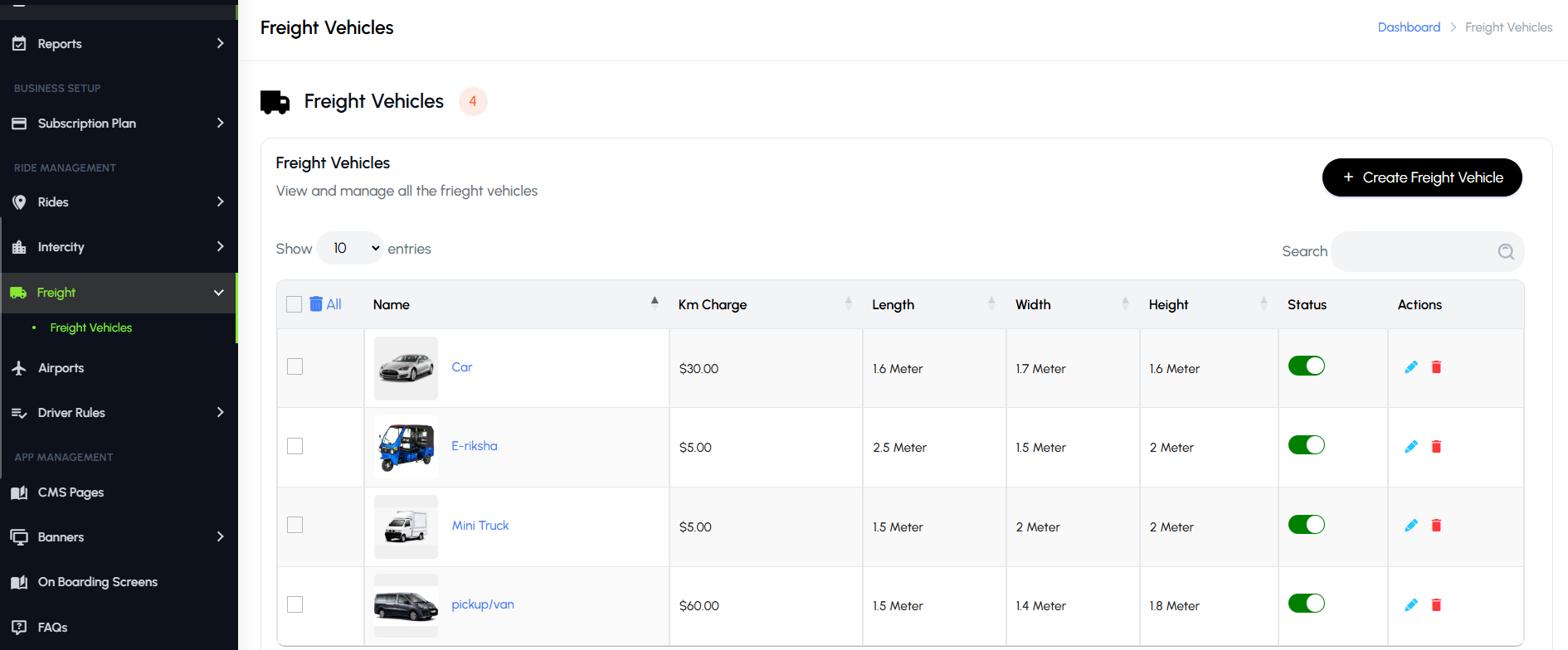
Airports
The Airports feature allows administrators to manage airport-related ride services. It includes adding airport locations, defining pick-up and drop-off points, and configuring fare rules for airport transfers. This helps ensure seamless airport rides, optimized driver allocation, and a smooth experience for passengers traveling to and from airports.
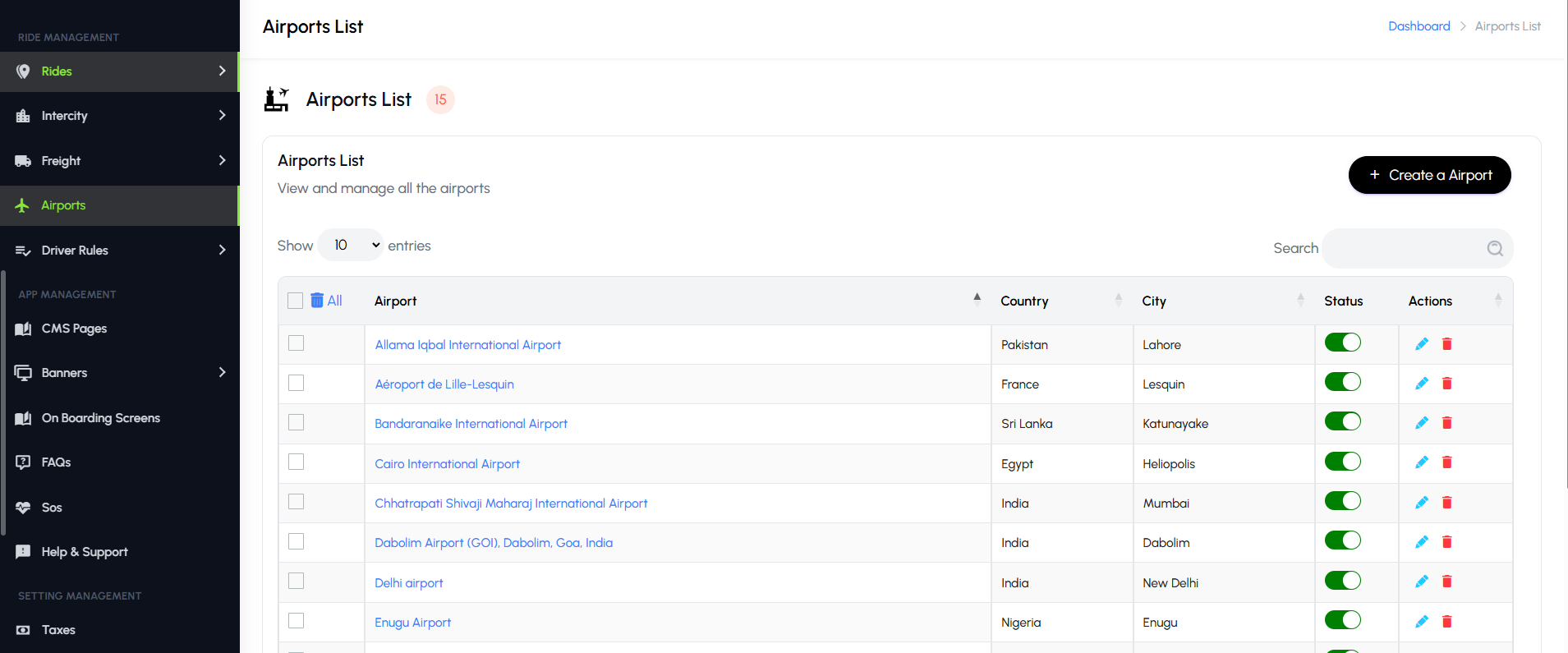
Driver Rules
Driver Rules define the specific guidelines that passengers must follow during a ride. This can include rules such as “Pets Allowed,” “No Alcohol,” “No Smoking,” or any custom conditions set by the driver. These rules help ensure a safe, comfortable, and respectful experience for both drivers and passengers while maintaining service quality and compliance.
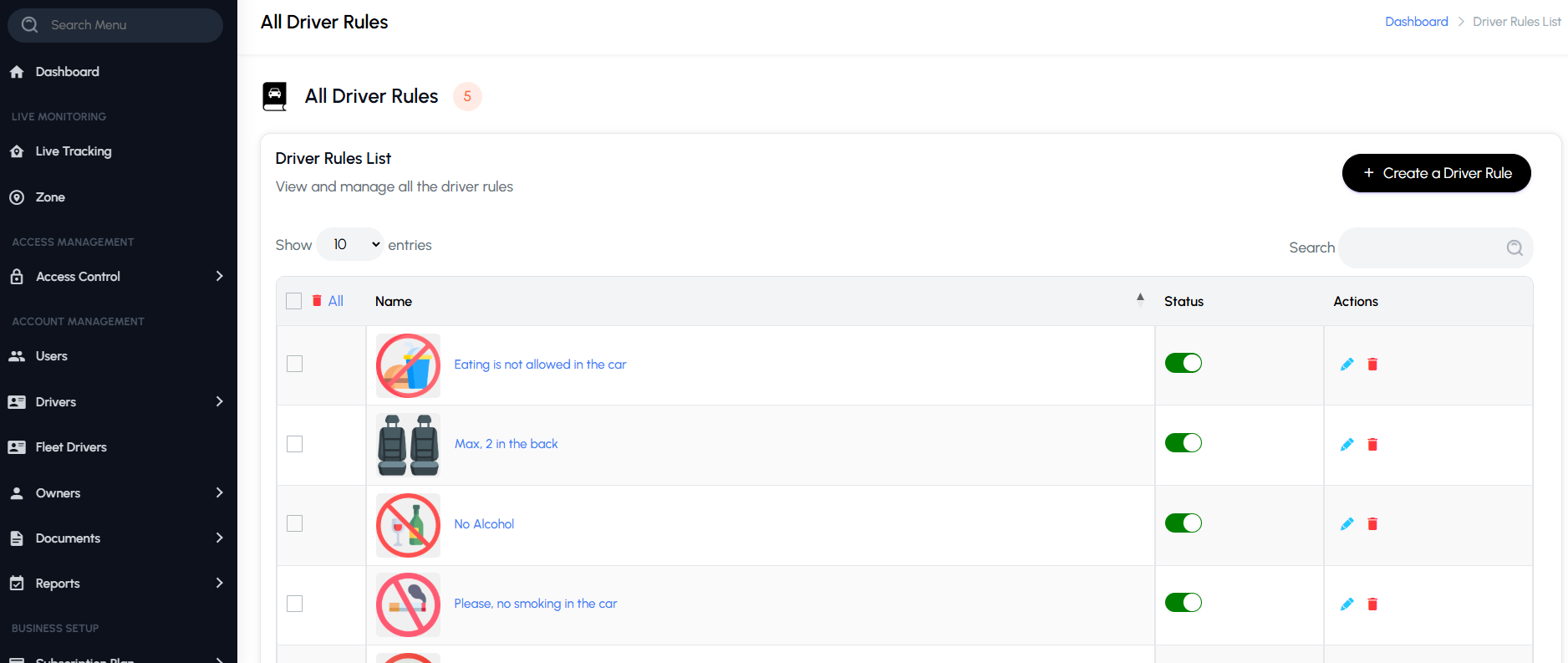
5.7. App Management
CMS Pages
The CMS Pages section allows administrators to create, edit, and manage static content pages within the app, such as About Us, FAQs, Terms & Conditions, Privacy Policy, and more. Each page can include text, images, and links, ensuring that essential information is clearly presented to users. Admins can update content anytime to reflect changes in policies, services, or company information. This page ensures that the app provides accurate and up-to-date information, improving transparency and user trust.
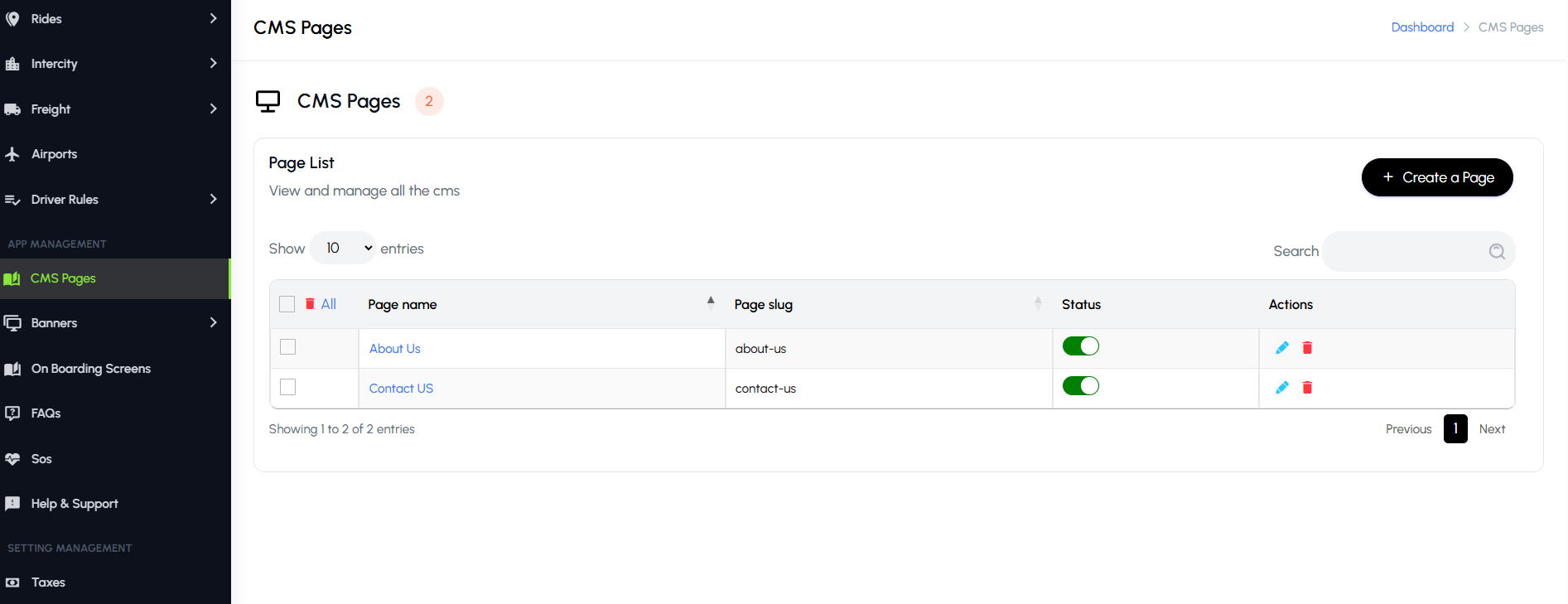
Banners
The Banners page allows administrators to create, manage, and display promotional or informational banners within the customer mobile application. Each banner can include images, text, links, or call-to-action buttons to highlight offers, updates, or important announcements. Admins can control the order, duration, and visibility of banners for different user segments, ensuring relevant and engaging content. This page helps enhance user experience, promote services effectively, and drive customer engagement through visually appealing notifications.

On Boarding
The On Boarding page allows administrators to configure the introductory screens shown to new users when they first open the mobile application. These screens can highlight key app features, explain how to use services, and provide tips for a smooth experience. Admins can add images, text, and interactive elements to make the onboarding process engaging and informative. This page ensures that new users quickly understand the app’s functionality, enhancing user adoption and reducing confusion during initial use.
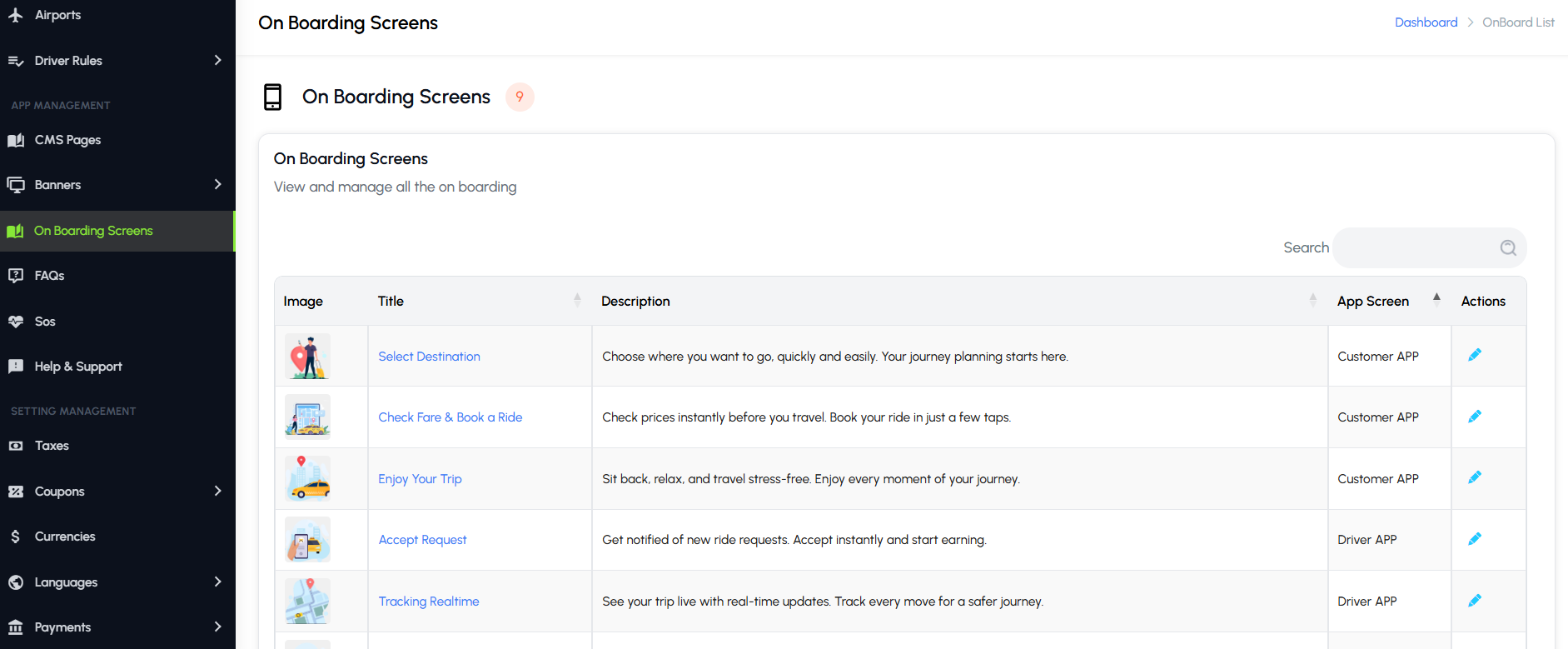
FAQ
The FAQ feature provides a centralized section for frequently asked questions by users. It allows administrators to add, edit, or remove questions and answers, covering topics such as booking procedures, payment methods, ride policies, and service guidelines. This helps improve user experience, reduce support requests, and ensure passengers and drivers have quick access to important information.
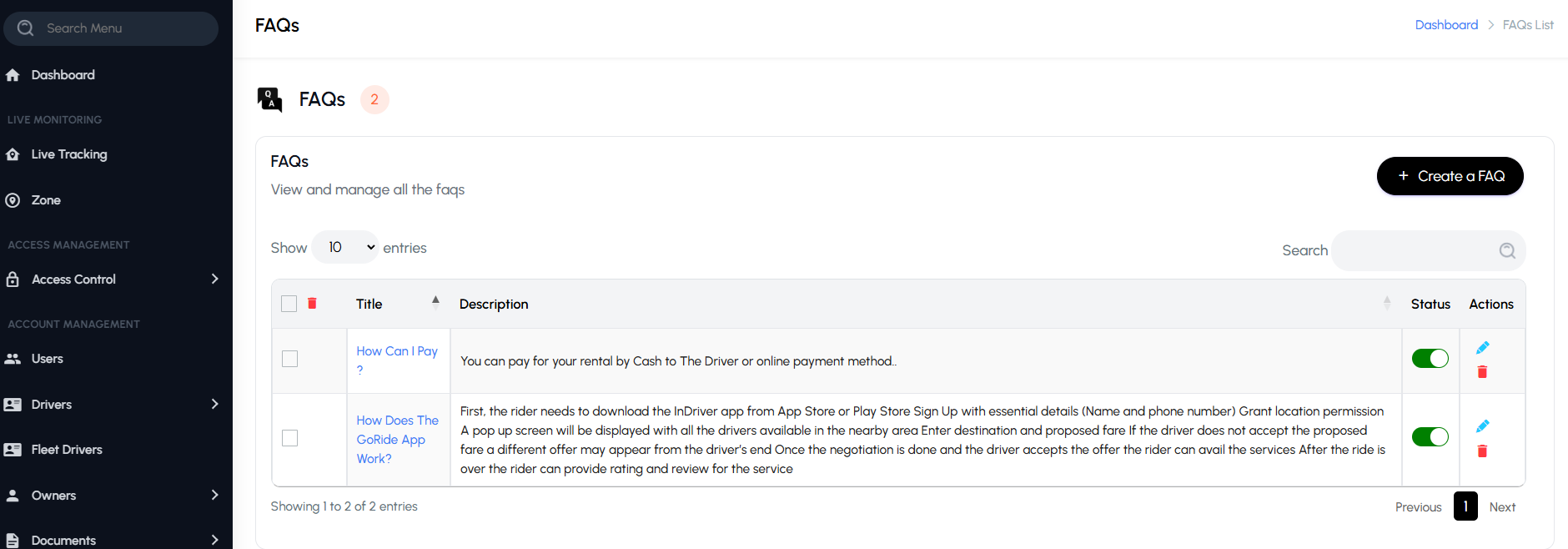
SOS
The SOS page enables administrators to monitor and manage emergency alerts raised by drivers or customers in real time. Each alert provides critical information such as the location, type of emergency, and the user involved. Admins can quickly track and respond to these SOS events, ensuring prompt assistance and intervention. This page helps improve safety across the platform by enabling rapid coordination, documenting incidents, and maintaining records for follow-up and preventive measures.
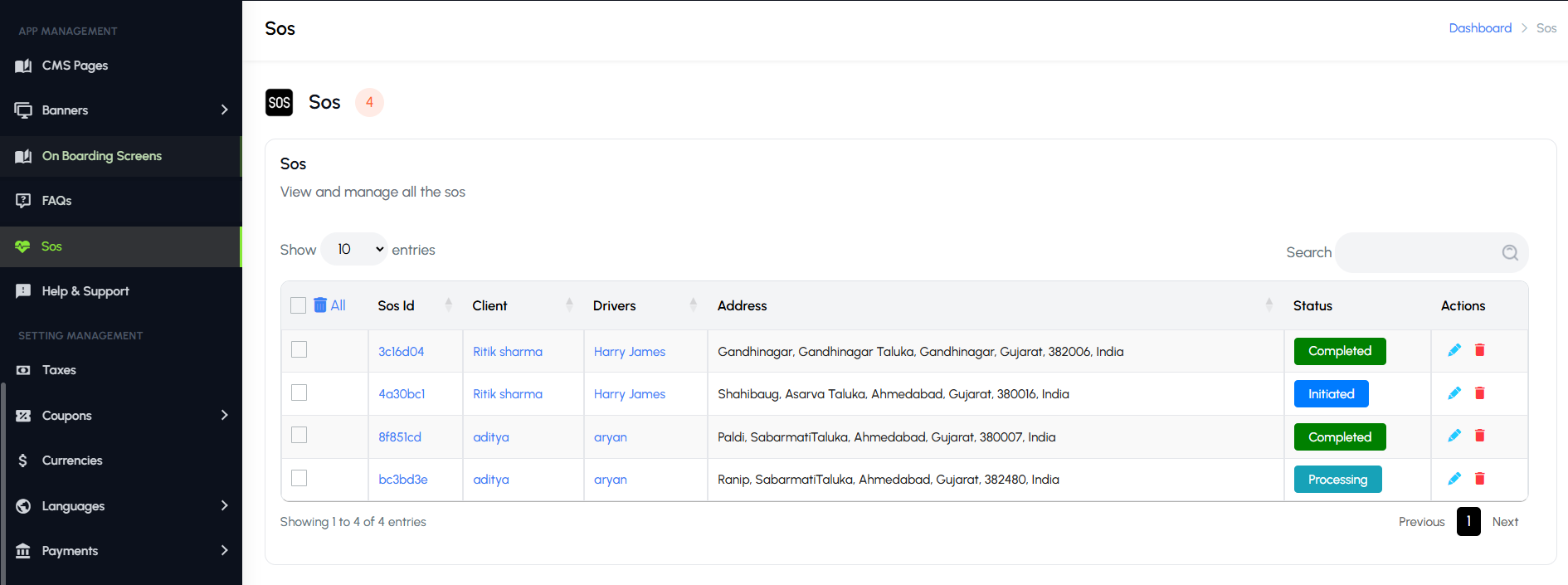
Help & Support
The Help & Support feature enables real-time communication between users and administrators. It includes a chat system where users can submit queries, report issues, or request assistance, and admins can respond promptly. This ensures timely support, enhances user satisfaction, and helps resolve ride-related or account issues efficiently.
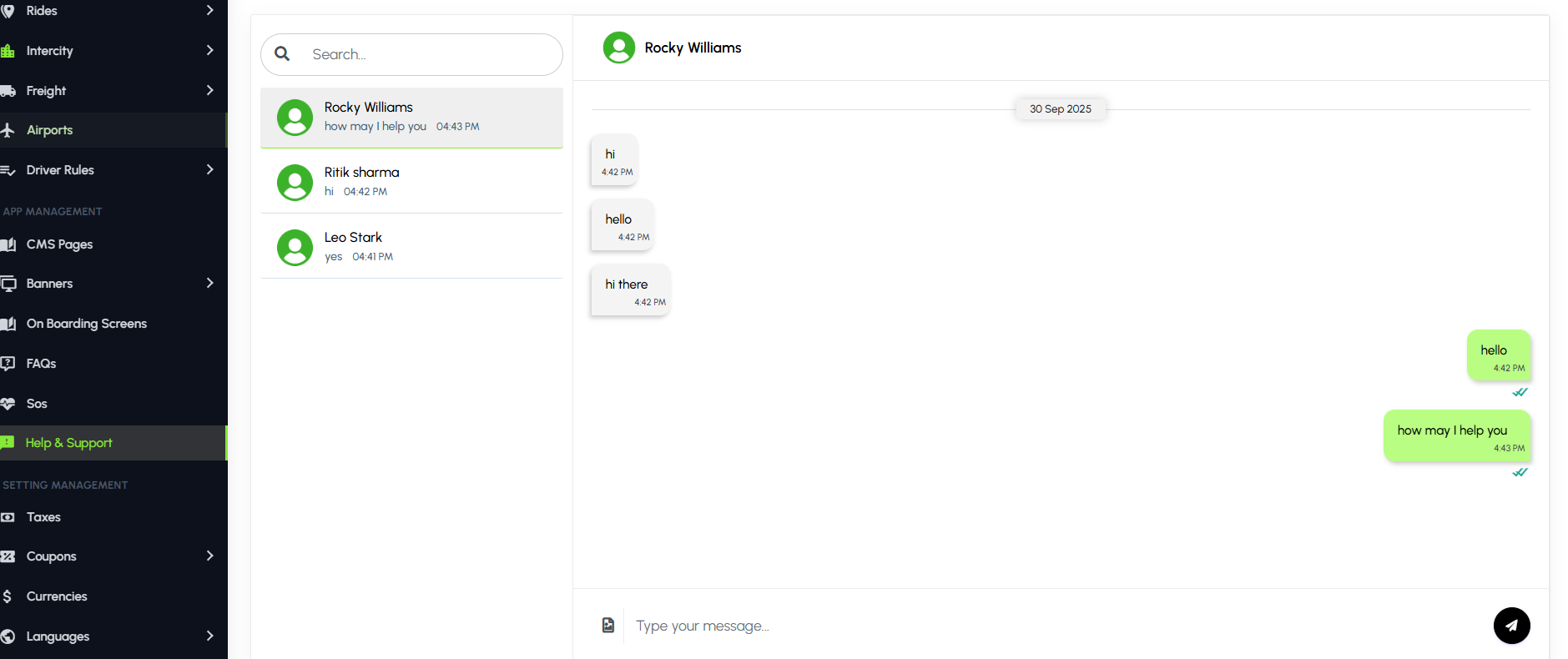
5.8. Setting Management
Tax Settings
The Tax Settings page allows administrators to configure taxes applicable across all services. Admins can define tax types such as GST, VAT, or other local taxes and specify rates for each service category. This page ensures that all fare calculations include accurate tax amounts, maintains compliance with local tax regulations, and provides transparency for customers and drivers. Proper tax configuration also helps in generating accurate financial reports and simplifies accounting and regulatory reporting.
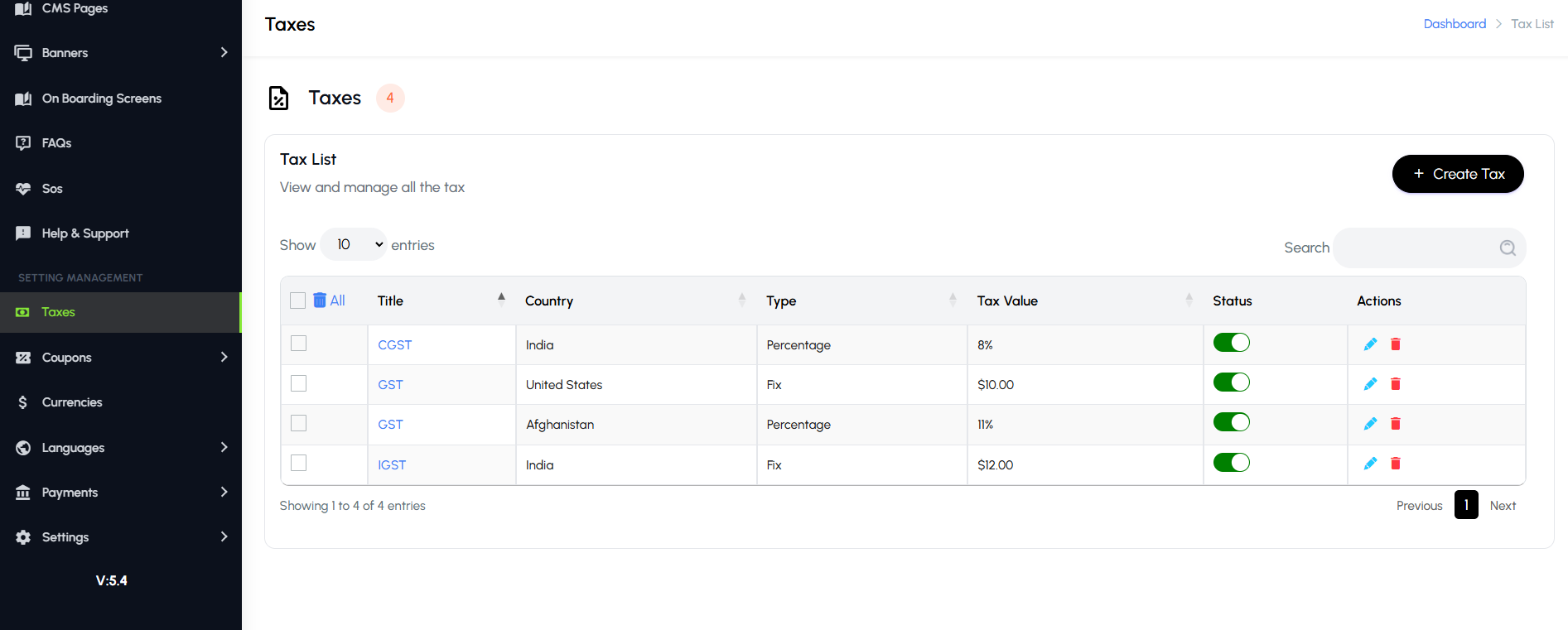
Coupons
The Coupons page enables administrators to create, manage, and monitor discount coupons and promotional codes that customers can apply during bookings. Each coupon can be configured with specific details such as discount type (percentage or fixed amount), validity dates, and maximum usage limits per customer or overall. Admins can also define which coupon applies to rides and allow for targeted promotions. This page provides visibility into coupon performance, including redemption counts and customer usage, helping businesses run effective marketing campaigns while controlling discounts and revenue impact.
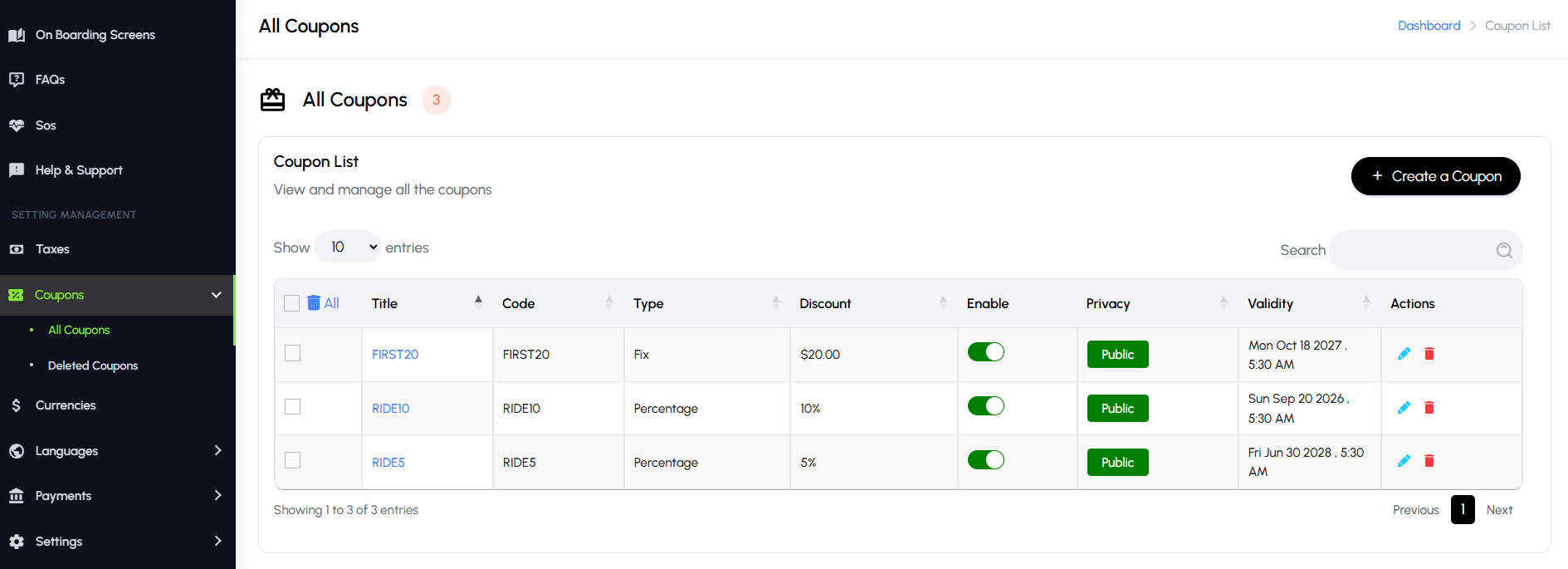
Currency
The Currency page allows administrators to define and manage the currencies supported by the platform. Admins can set default currencies, add additional currencies for global operations, and configure exchange rates to ensure accurate pricing and billing across regions. This page helps maintain consistency in financial transactions, supports multi-currency operations, and ensures that both customers and drivers see correct amounts in their local currency.

Languages
The Languages page allows administrators to manage the languages available in the admin panel. Admins can add new languages, edit existing translations, and update labels or messages to ensure the interface is accessible to a diverse team. This page helps maintain consistency across the admin panel, supports multi-lingual operations, and ensures that administrators can efficiently manage the platform in their preferred language.
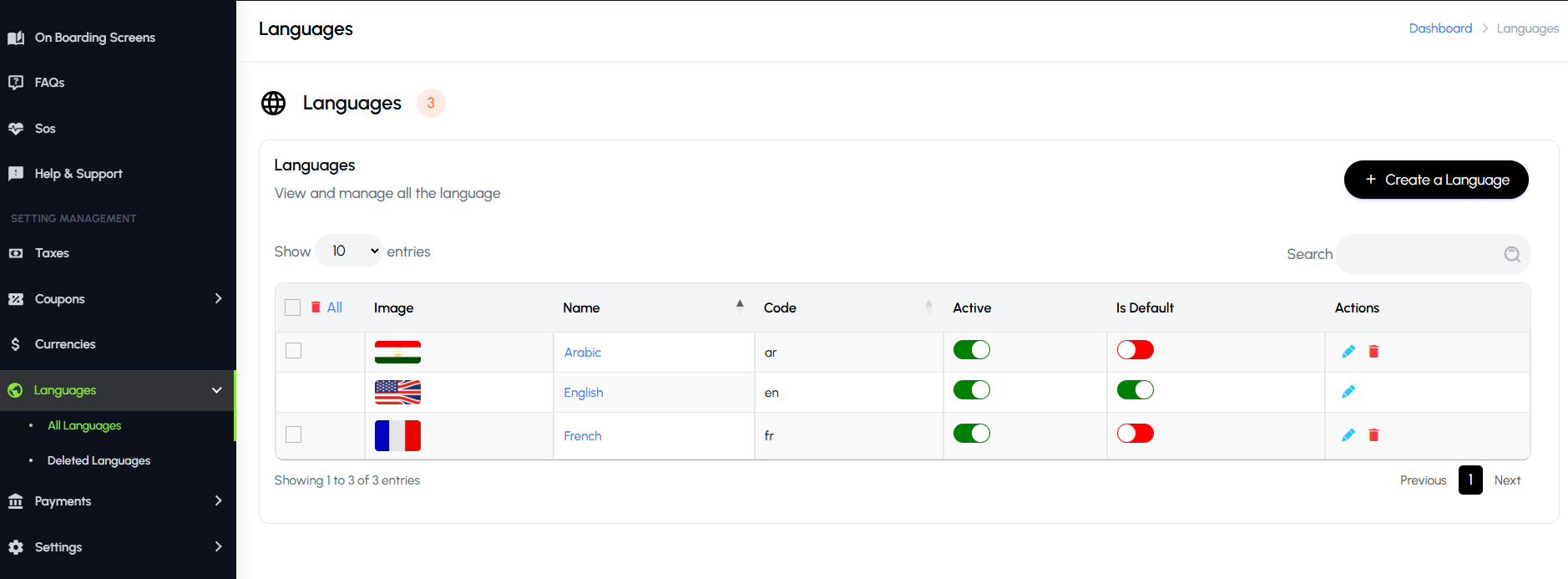
Payments
The Payments section provides a comprehensive view and management of all financial transactions within the platform. It includes:
Payout Requests: Tracks and manages withdrawal requests from drivers or service providers, ensuring timely and accurate payouts.
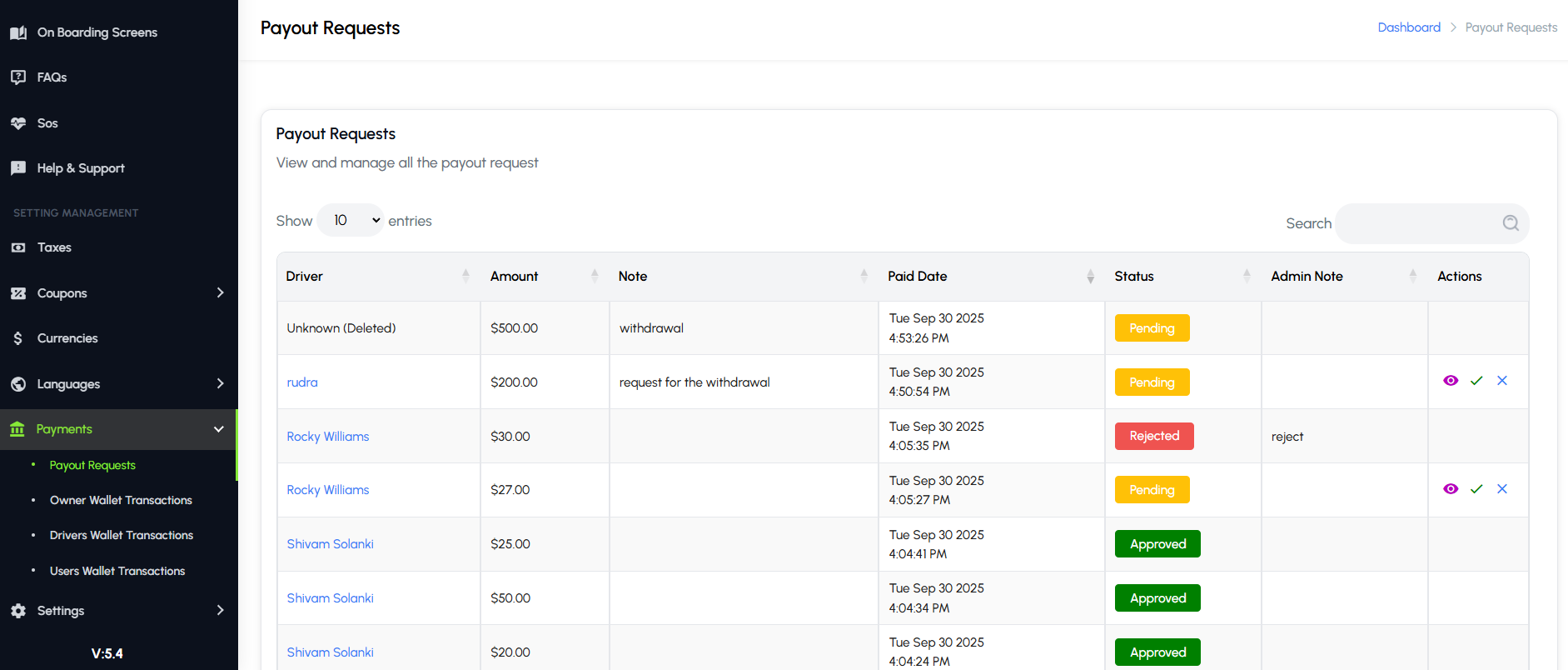
Owner Wallet Transactions: Monitors all credit and debit activities in the platform owner’s wallet, including commissions, refunds, and adjustments.
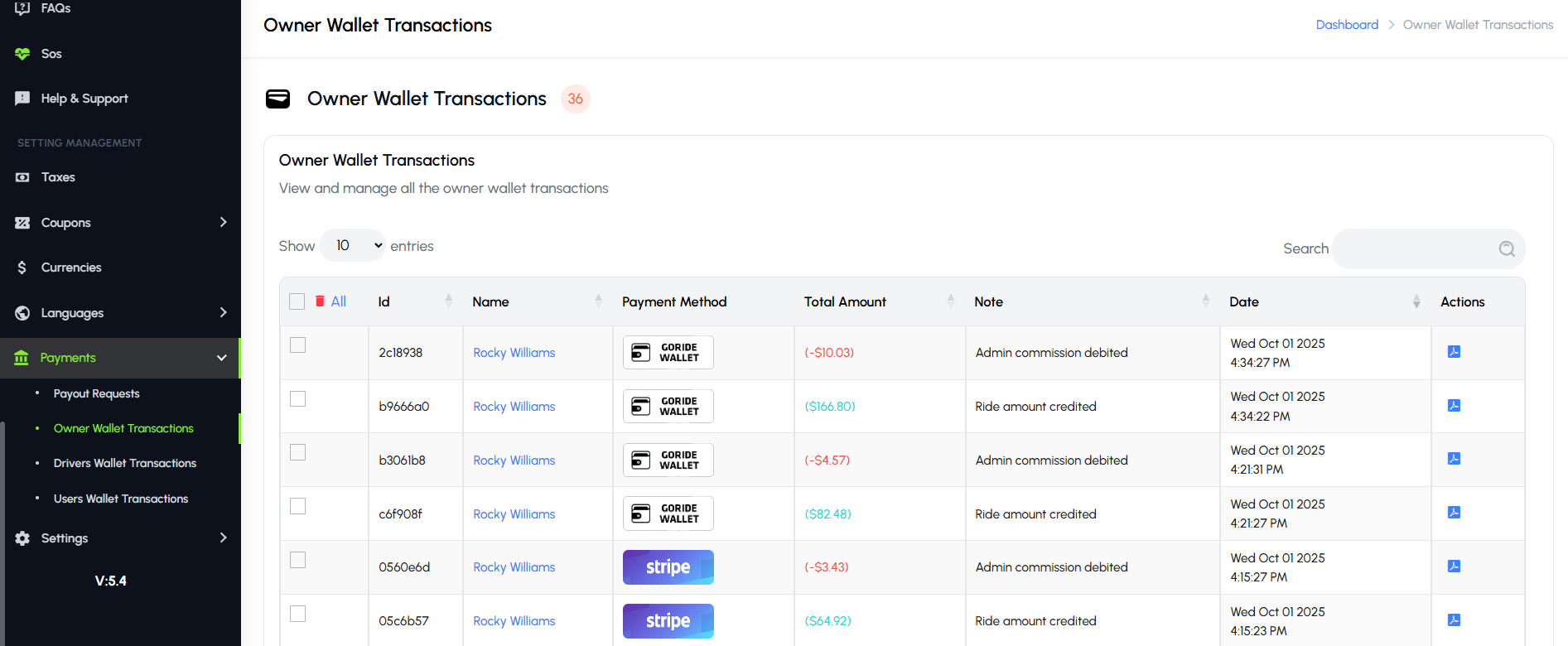
Driver Wallet Transactions: Records earnings, incentives, and deductions for drivers, providing transparency and easy reconciliation.
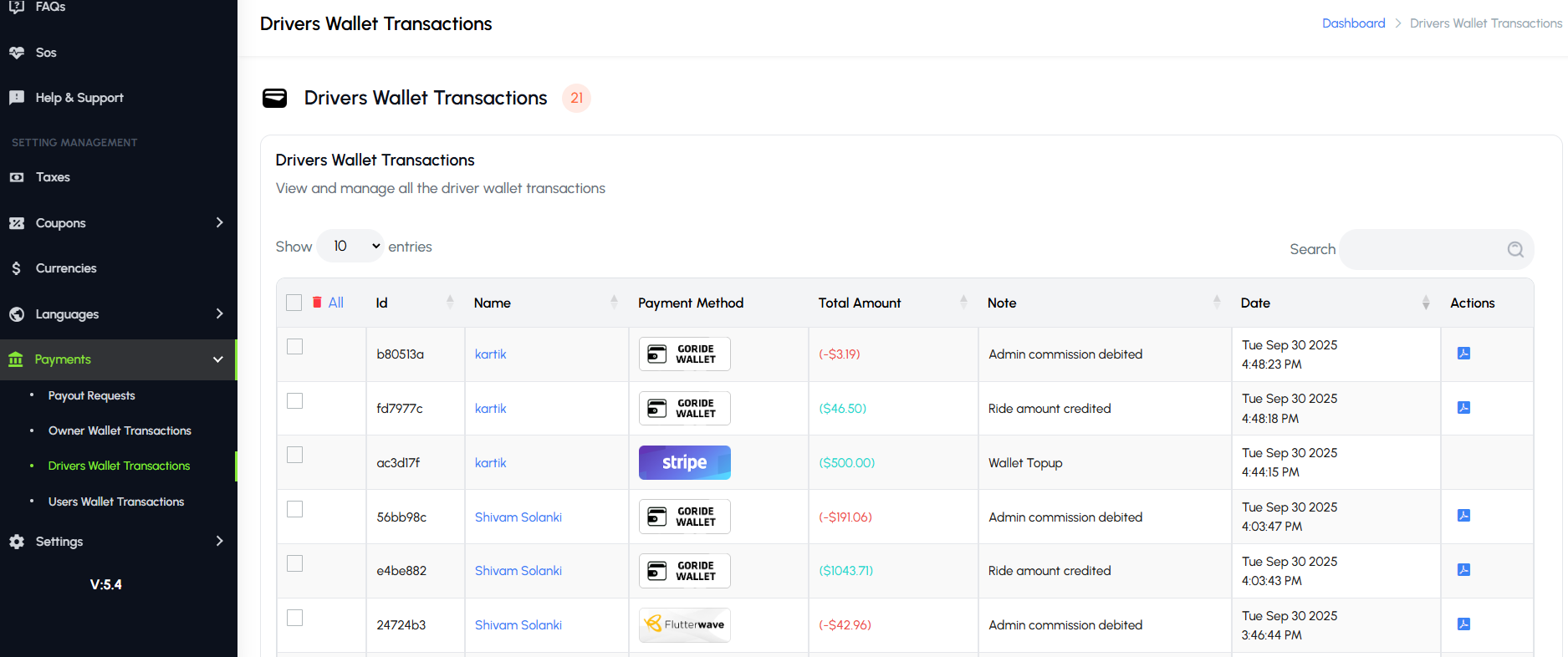
User Wallet Transactions: Displays top-ups, payments, refunds, and promotional credits for users, ensuring smooth and secure financial
operations.
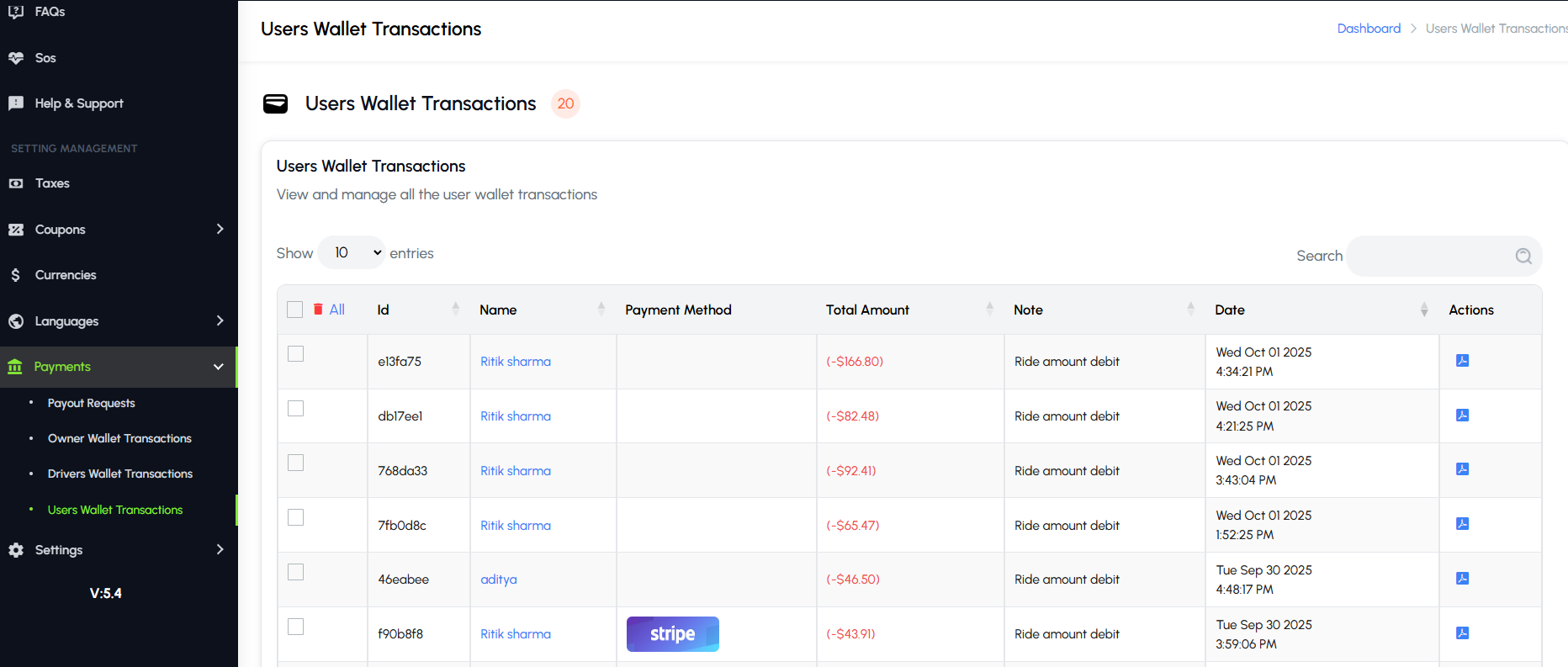
This section helps administrators maintain transparency, manage finances efficiently, and ensure accurate tracking of all monetary activities across the platform.
Settings
Global Settings
The Global Settings page allows administrators to configure all core settings for the app, web panel, and overall platform operations. These settings ensure the platform runs smoothly, maintains consistent branding, and meets operational requirements.
Admins can define the basic platform appearance and identity:
- Title & Footer: Customize the platform’s name and footer text.
- App Color, Admin Panel Colors: Set color schemes for both mobile app and admin panel for consistent branding.
- Radius: Configure service coverage radius for rides.
- Logo: Upload platform or company logo for display across app and admin panel.
- etc.
Business Model Settings
The Business Model Settings page allows administrators to define how the platform generates revenue from drivers and fleet owners. Admins can choose between different earning models:
- Commission Model: The platform earns a percentage of each completed ride transaction.
- Subscription Model: Drivers or fleet owners pay a recurring subscription fee to access the platform’s services.
- Hybrid Model: Combines both commission and subscription-based earnings, allowing flexible revenue strategies.
This page ensures that the platform’s revenue model aligns with business objectives and provides flexibility to adapt to market demands or strategic changes. Administrators can adjust settings easily to implement the chosen model across all services.
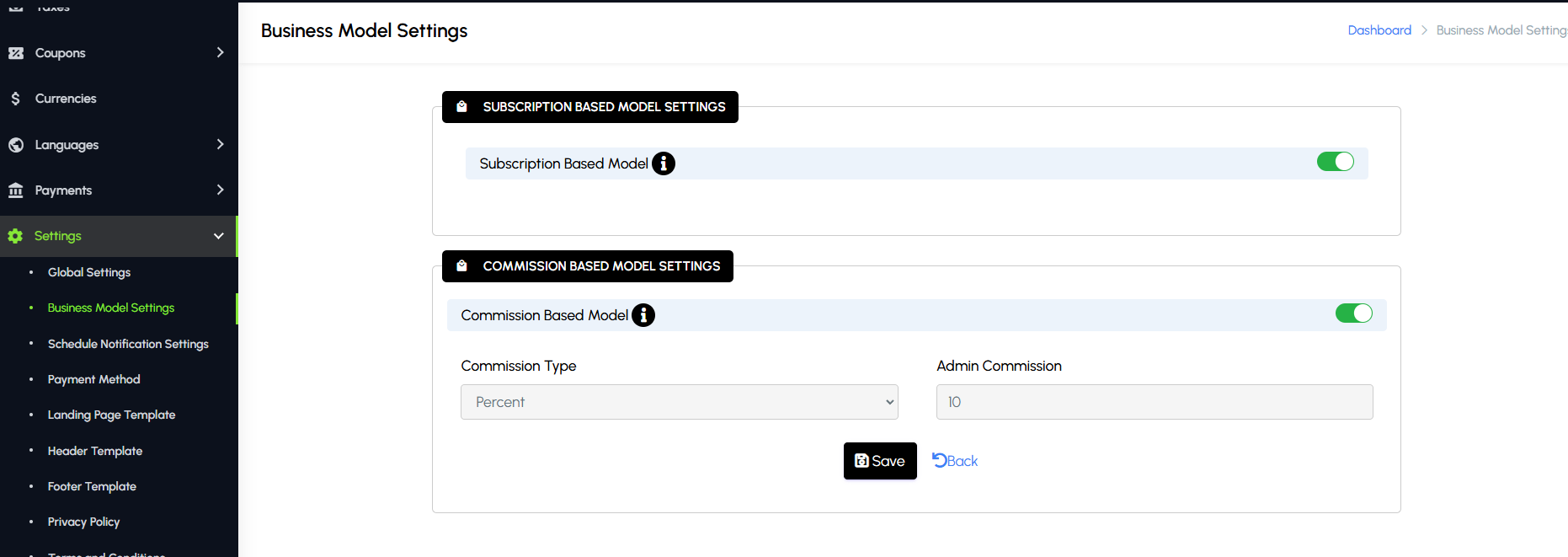
Schedule Notification Settings
Schedule Notification Settings allow administrators to configure automated notifications for upcoming rides. They can set the timing of alerts to be sent to users and drivers, such as 1 day, several hours, or minutes before the ride. This ensures timely reminders, reduces missed bookings, and enhances overall communication and service reliability.
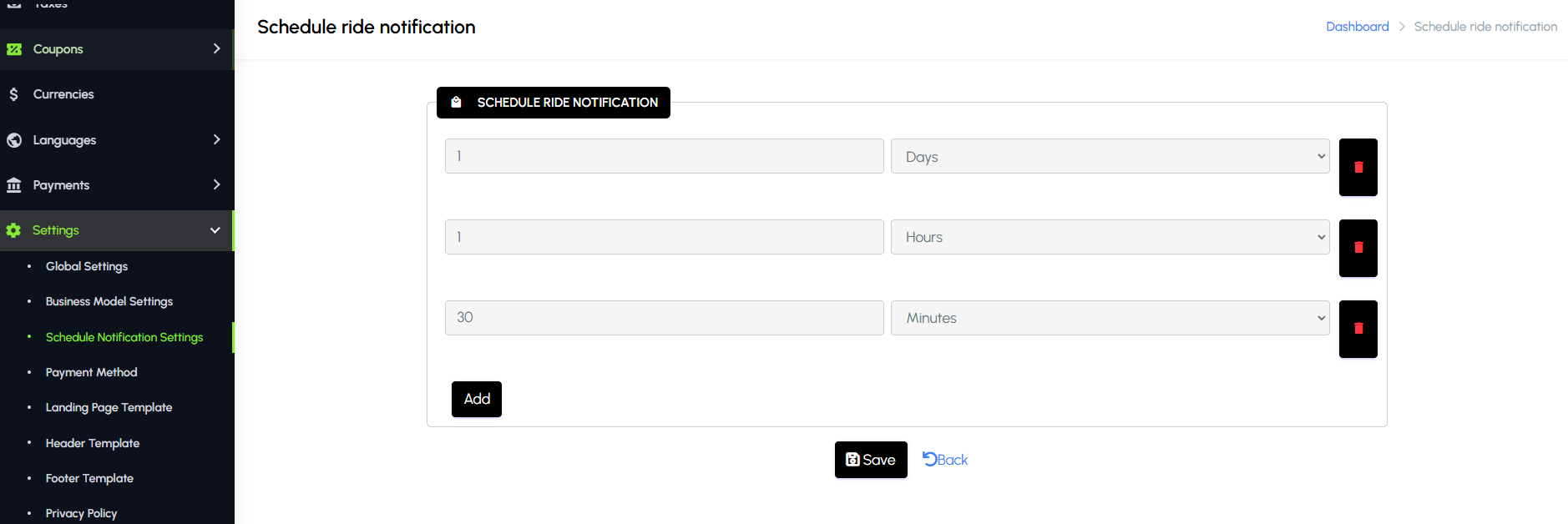
Payment Method
The Payment Methods page allows administrators to configure and manage the payment options available on the platform. Admins can enable or disable various gateways, including Cash, Stripe, PayPal, Razorpay, and Wallet payments, ensuring flexibility for both customers and drivers. This page ensures secure and seamless transactions, helps accommodate user preferences, and provides control over which payment methods are active for rides. Proper configuration also enables smooth reconciliation of payments and supports accurate financial reporting.
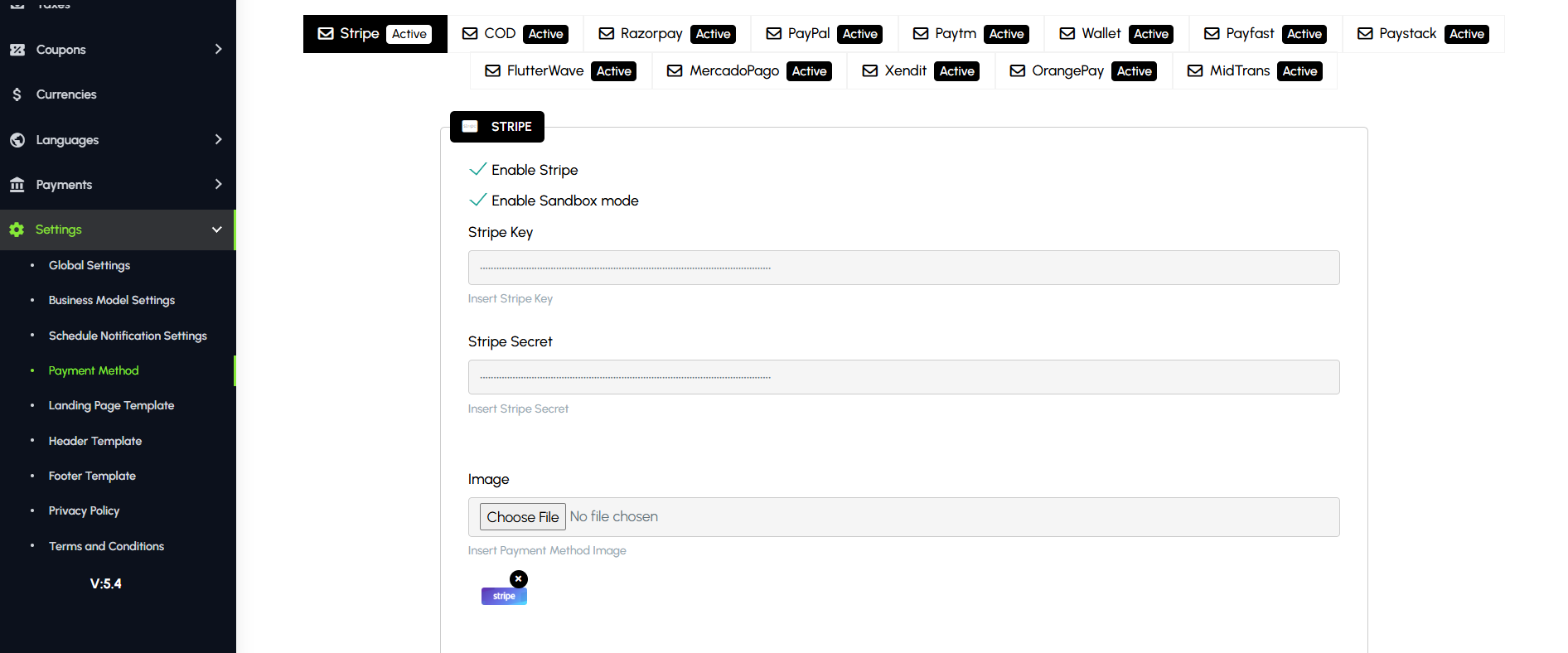
Landing Page Template
The Landing Page Template page allows administrators to manage and customize the public-facing landing page of the CabMe platform. Admins can update banners, text content, images, and branding elements to reflect current promotions, company identity, or seasonal campaigns. This page provides control over the look and feel of the landing page, ensuring it is visually appealing, informative, and aligned with marketing objectives. It helps attract new users, communicate key messages effectively, and maintain a professional online presence.
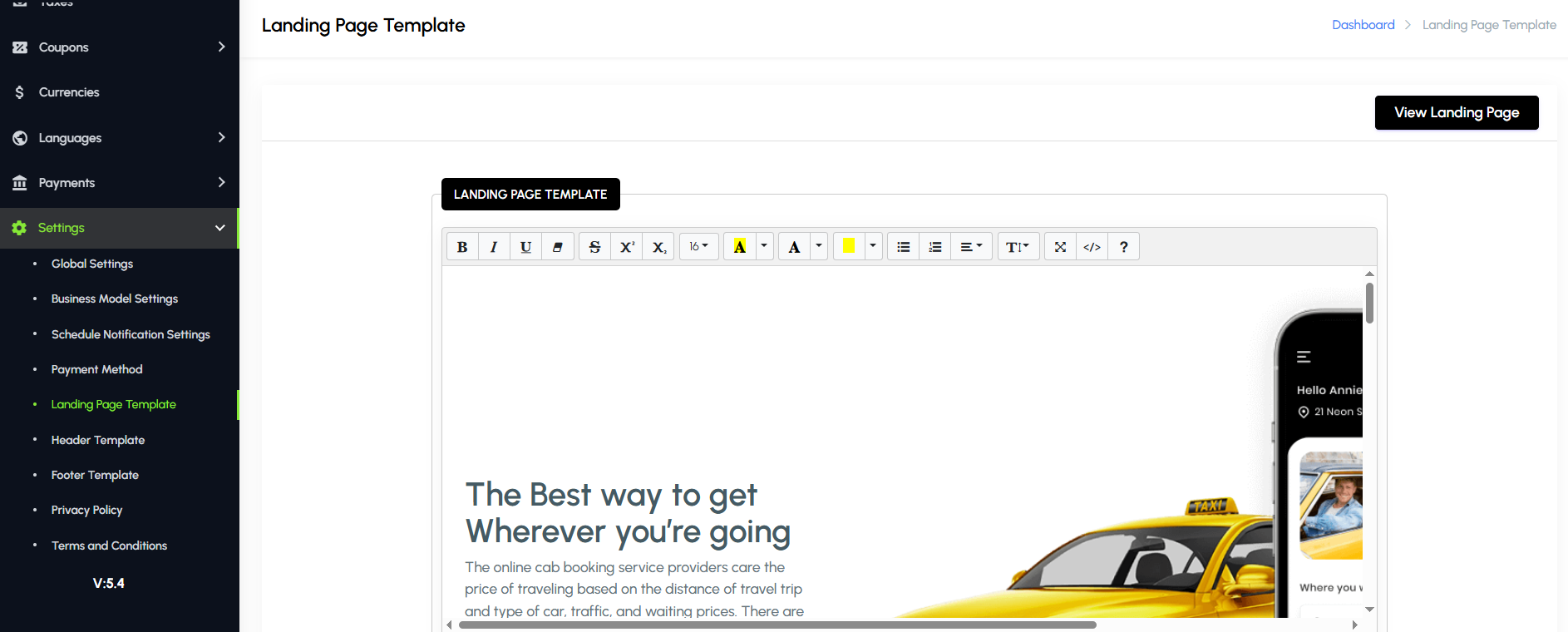
Header Template
Header Template allows administrators to customize the top section of the web application. This includes configuring the logo, navigation menus, links, and other elements visible to users. It ensures a consistent, branded interface and provides easy access to key pages and features of the website.
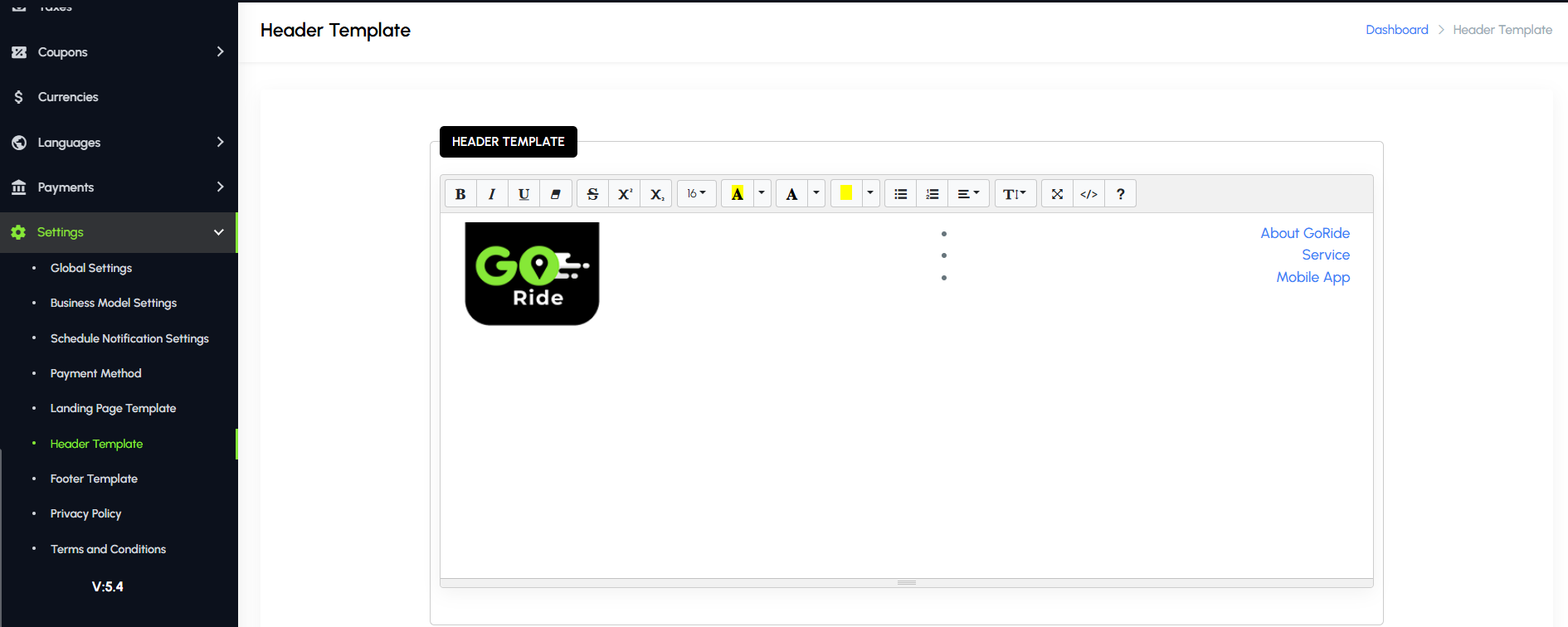
Footer Template
Footer Template allows administrators to customize the bottom section of the web application. This includes configuring links, contact information, social media icons, copyright text, and other elements visible to users. It ensures a consistent, branded interface and provides easy access to important information and resources across the website.
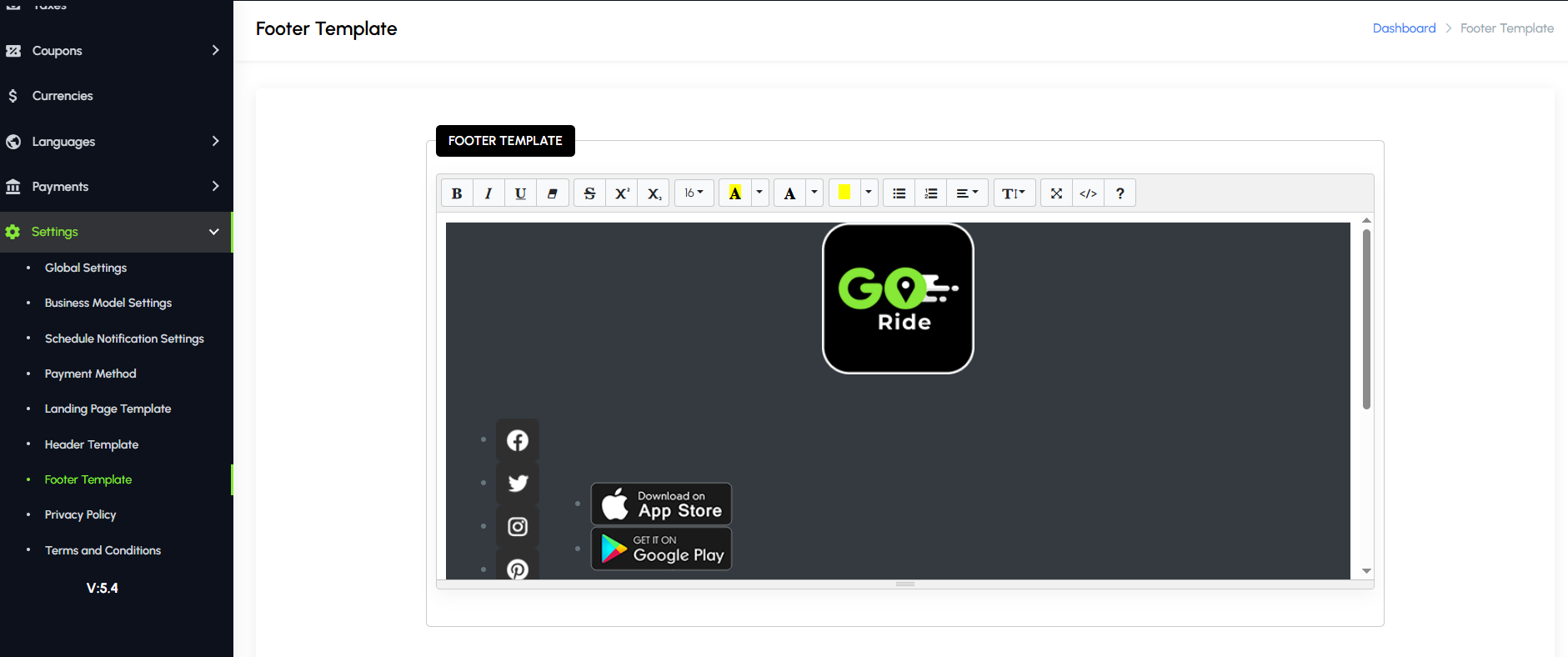
Privacy Policy
The Privacy Policy page allows administrators to create, update, and maintain the privacy policy content displayed to users within the app. Admins can ensure the policy complies with regulations such as GDPR and local data protection laws, clearly explaining how user data is collected, stored, and used. This page helps build trust with users, maintain legal compliance, and provide transparency regarding data privacy and security practices.
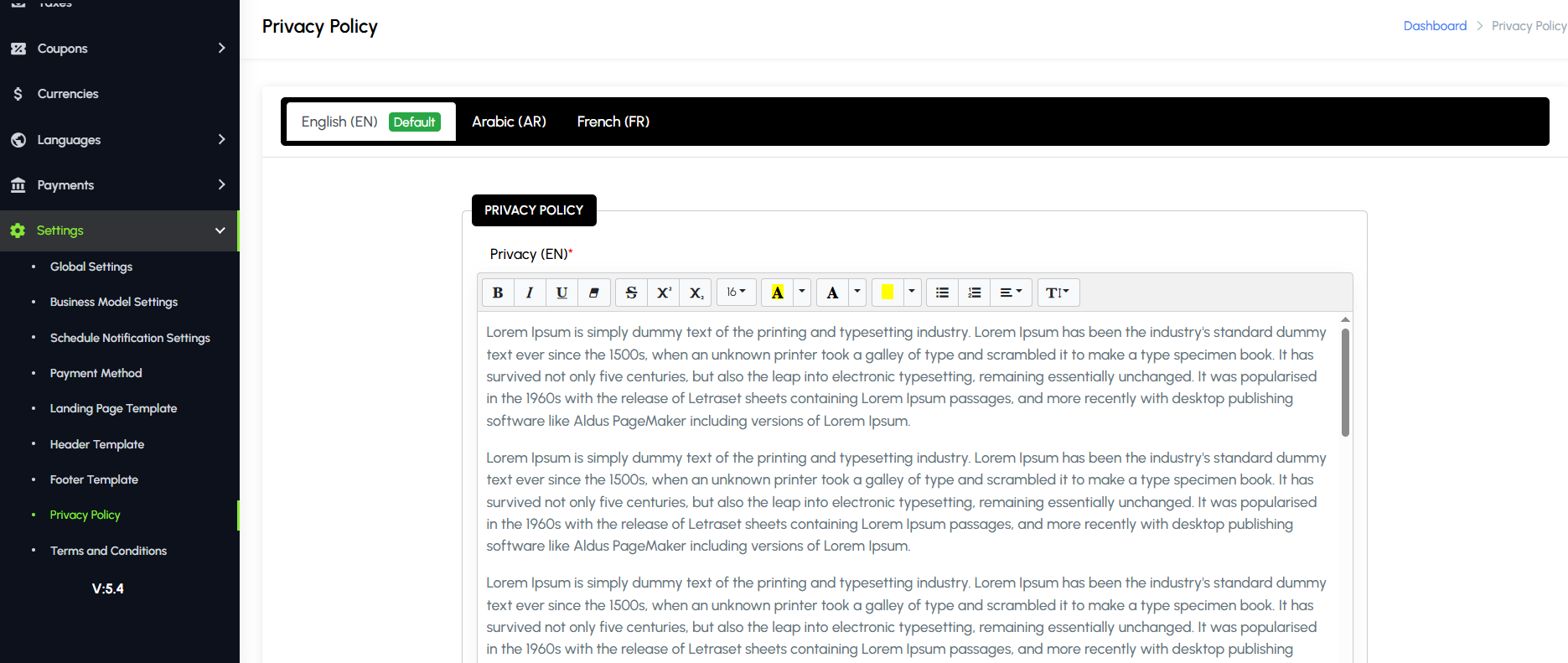
Terms & Conditions
The Terms & Conditions page allows administrators to create, update, and maintain the legal agreements displayed to users within the app. Admins can edit content to reflect company policies, service rules, and regulatory requirements, ensuring that users are informed about their rights and obligations. This page helps maintain legal compliance, provides transparency, and protects both the platform and its users by clearly communicating the terms of service.
